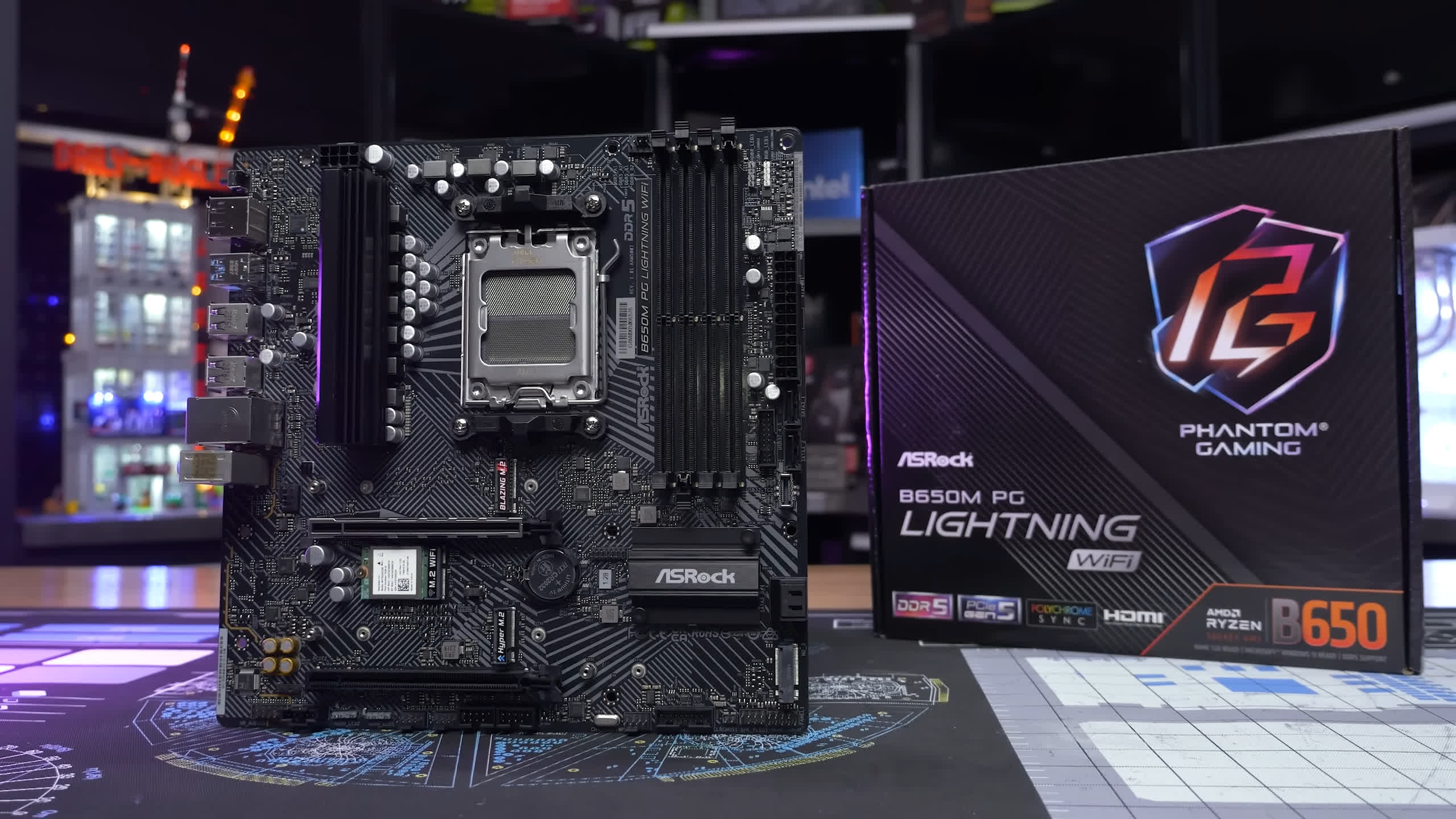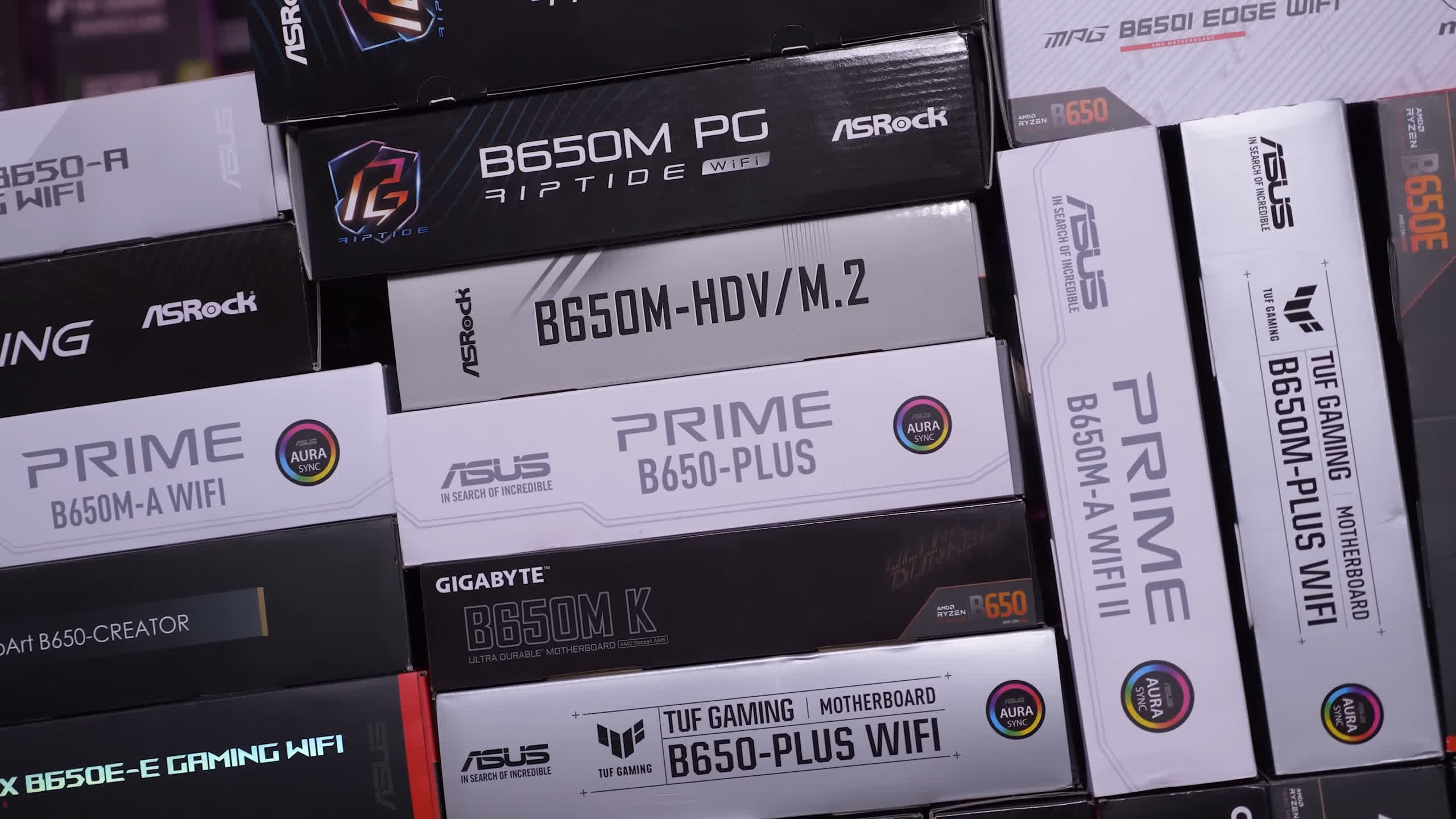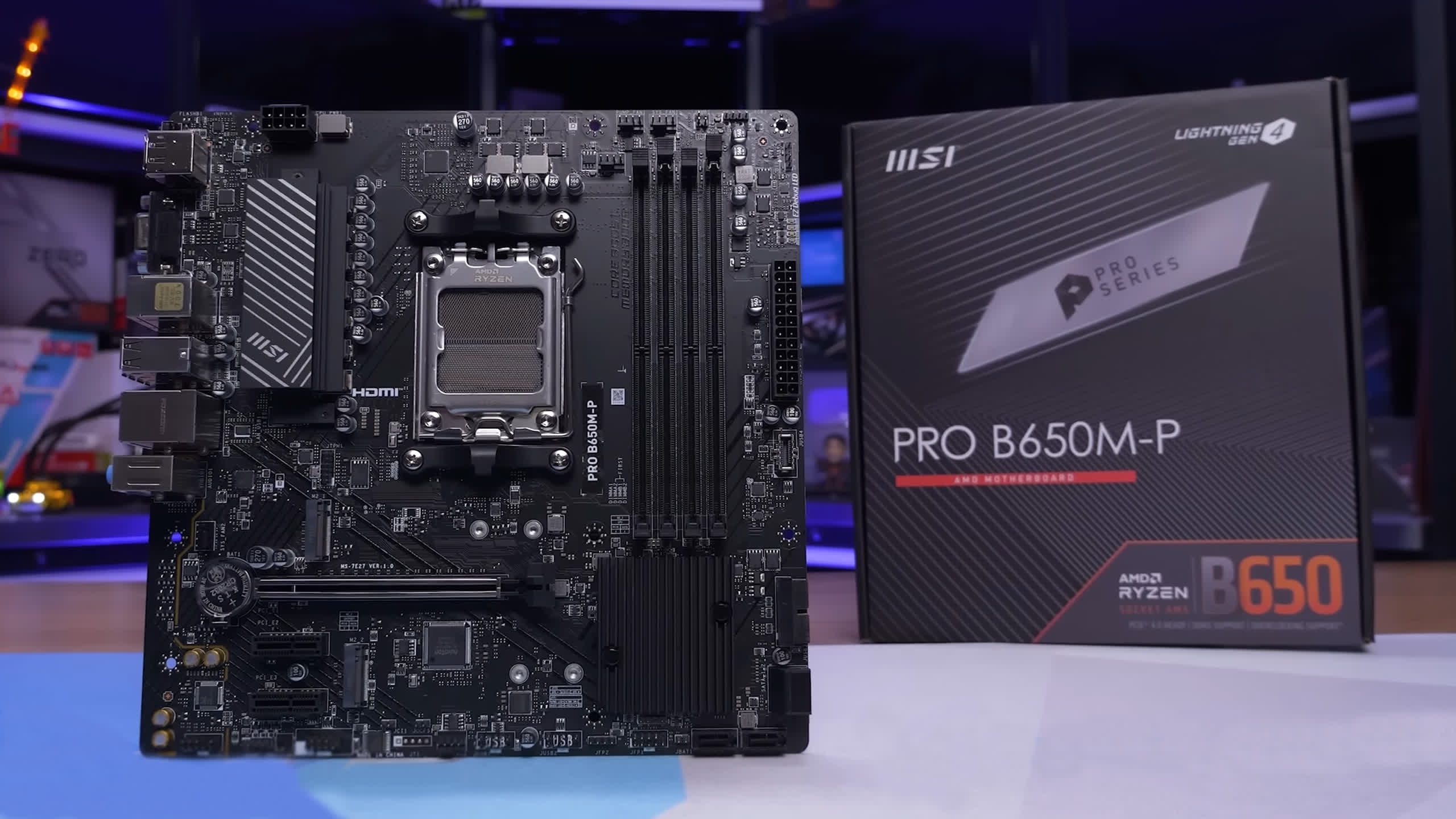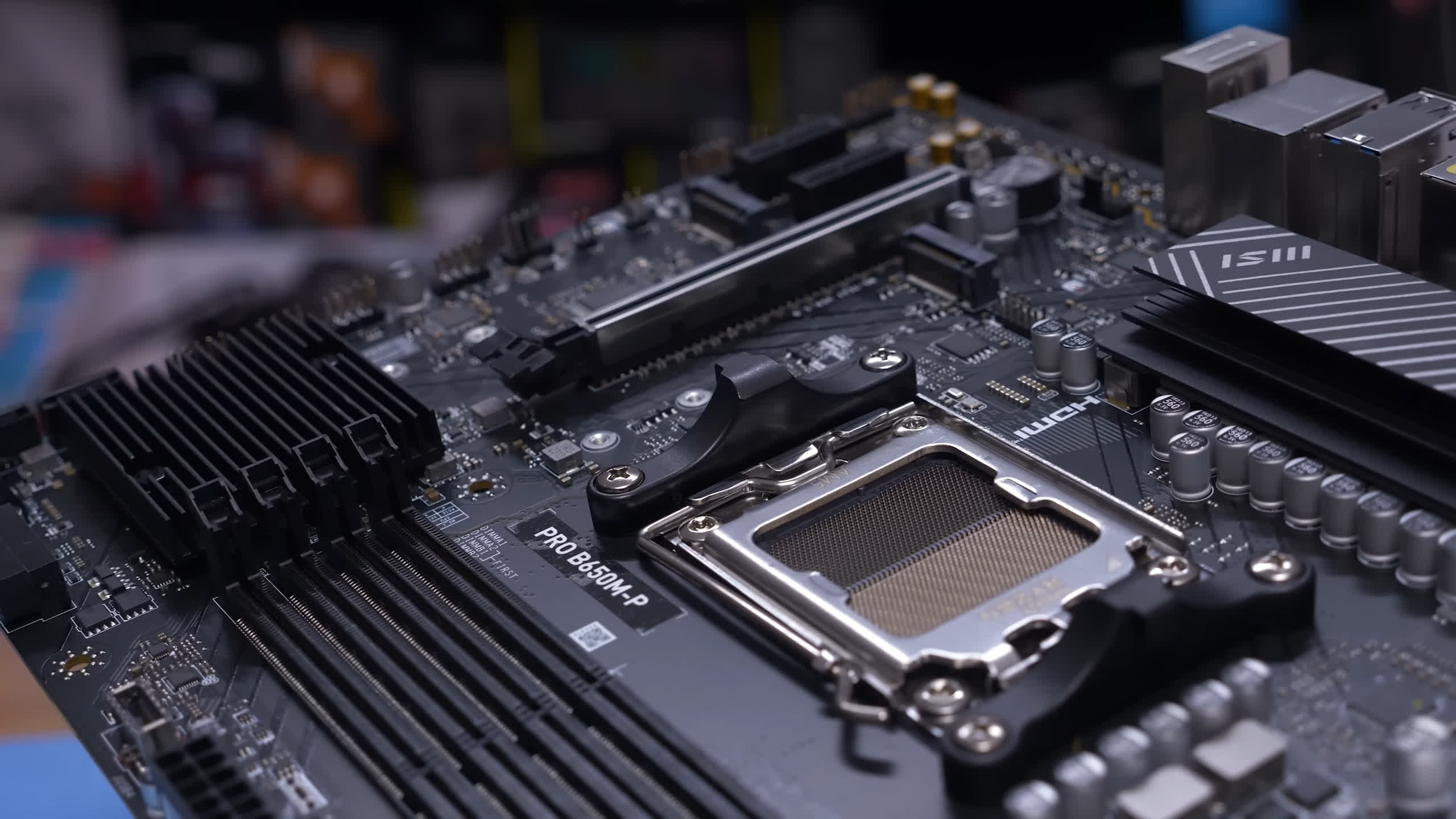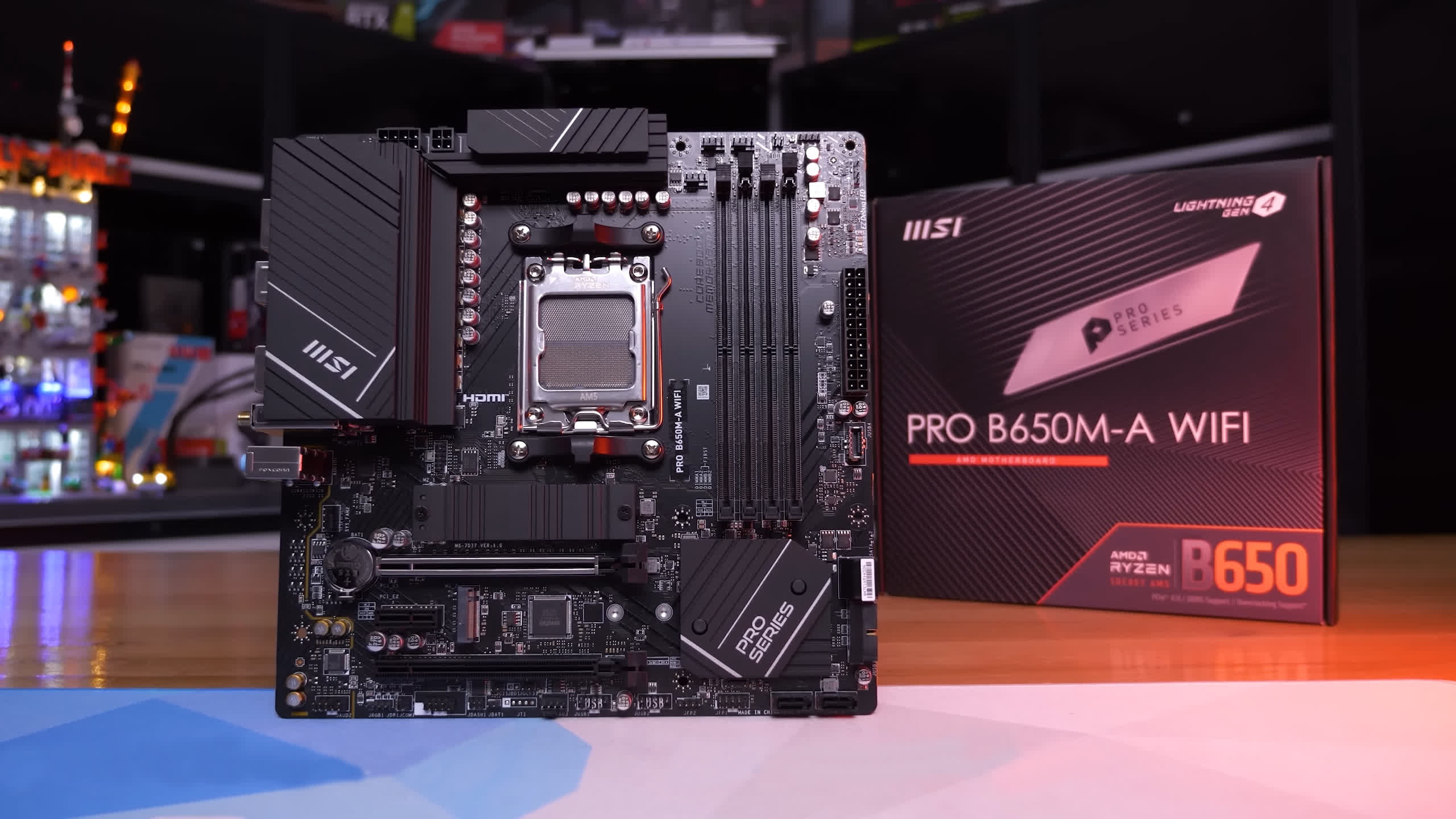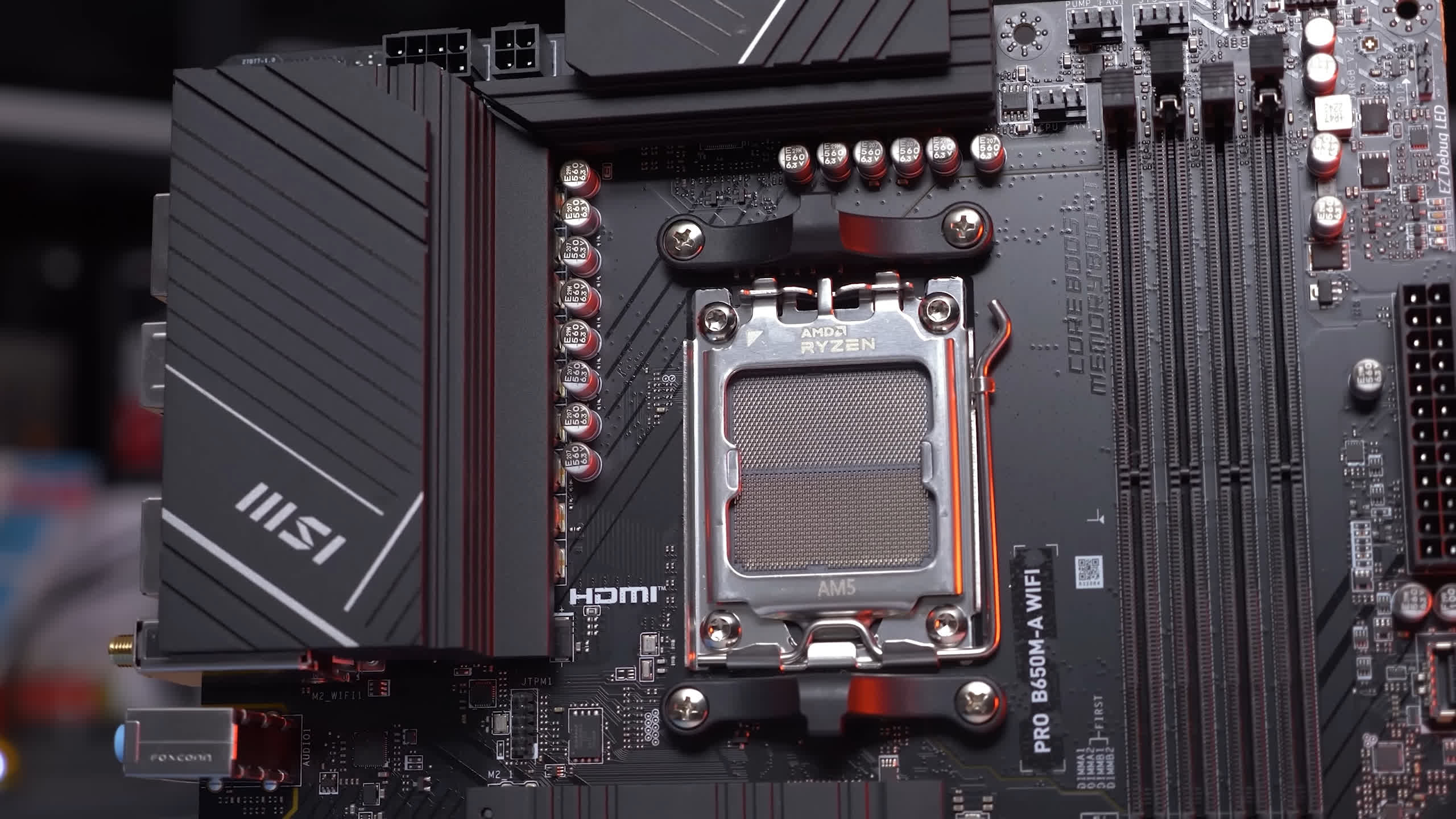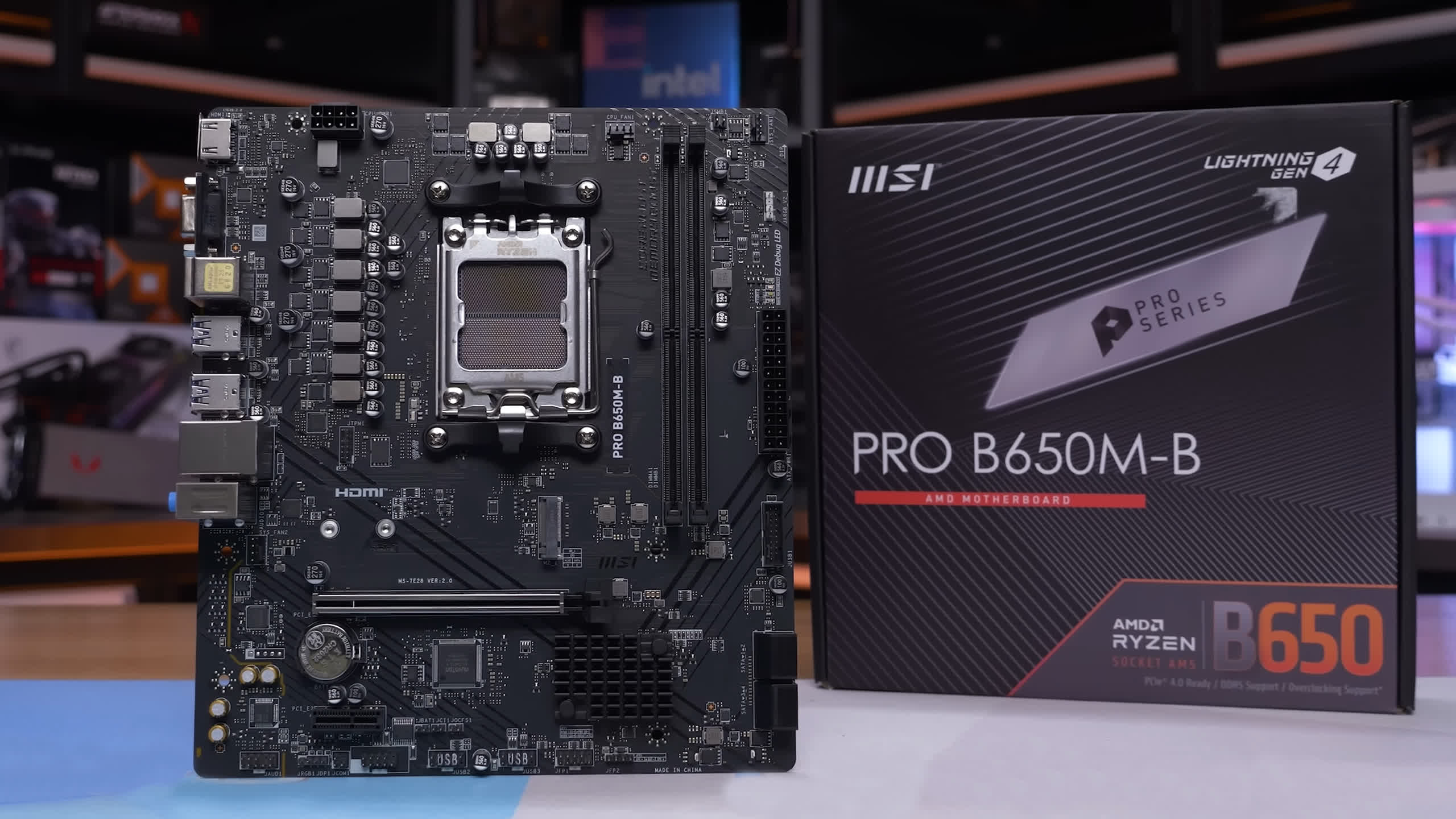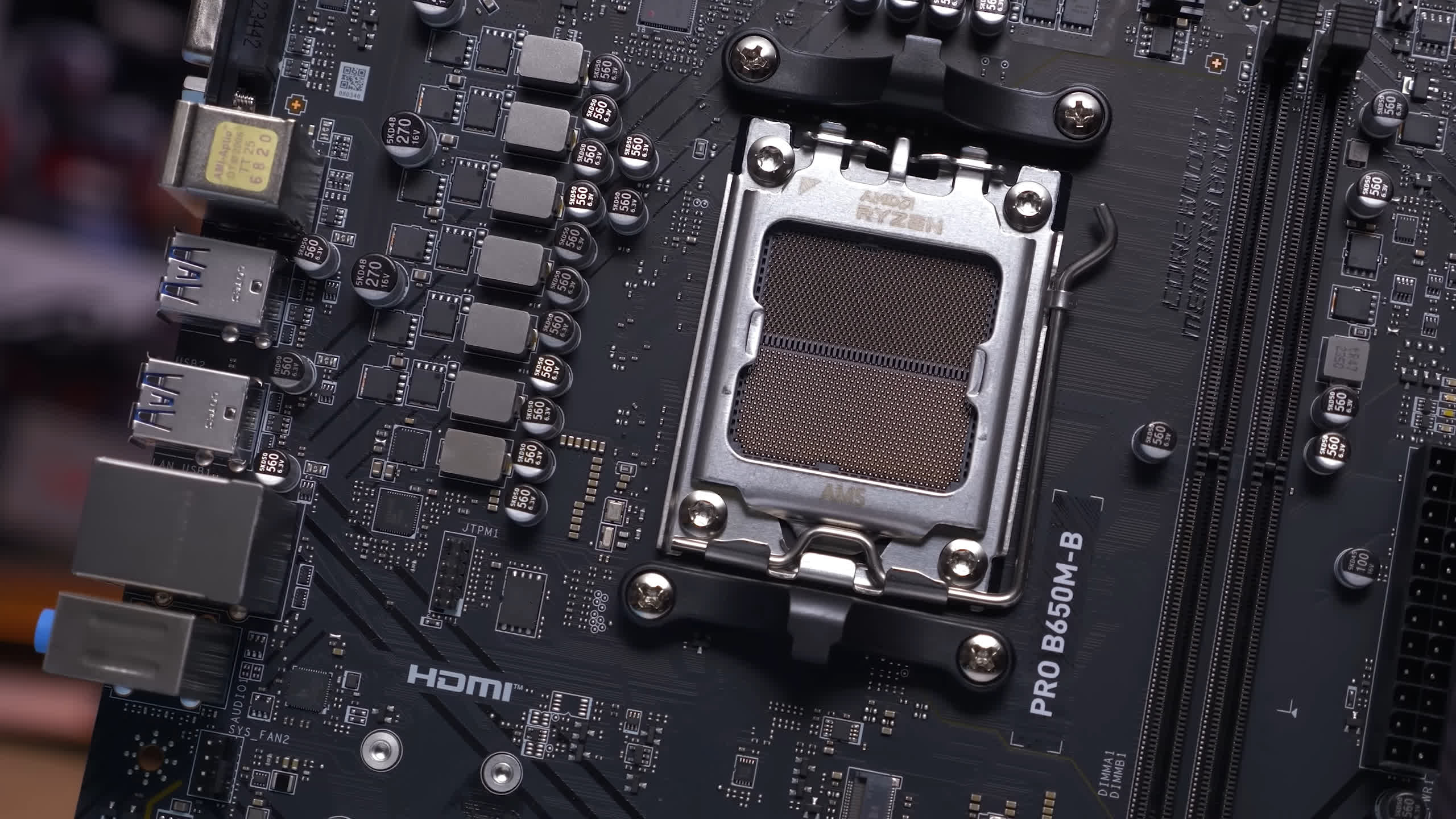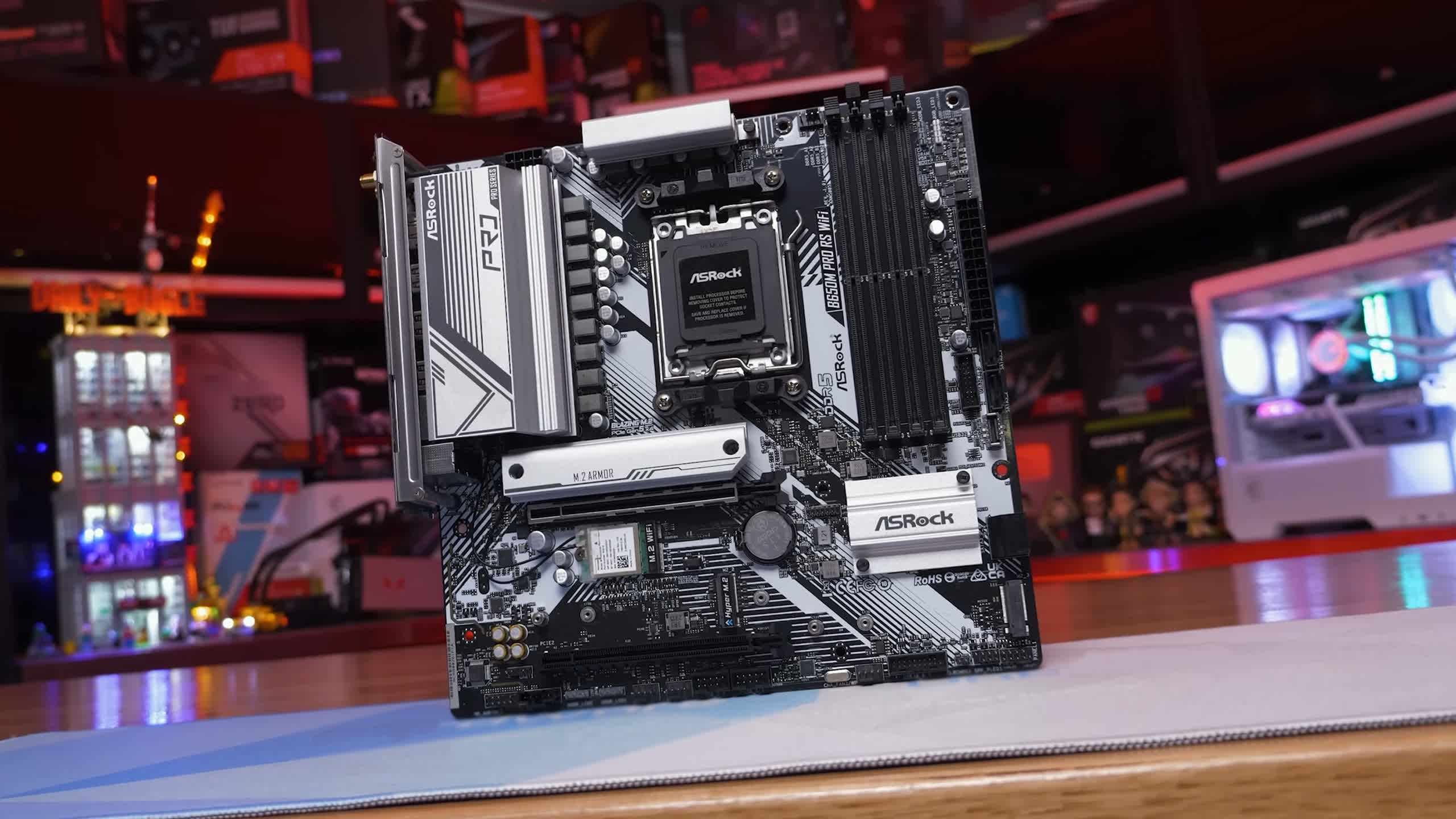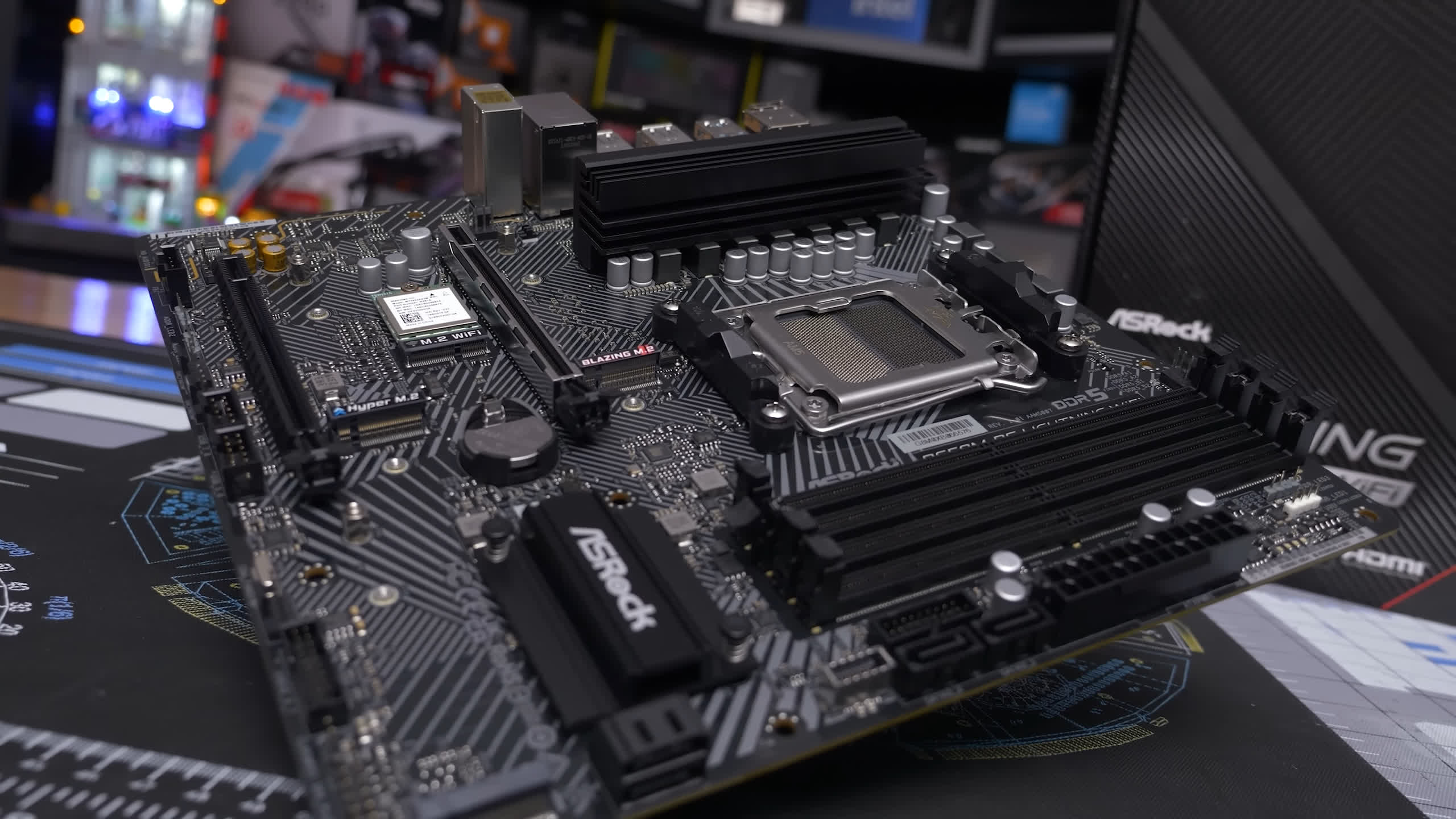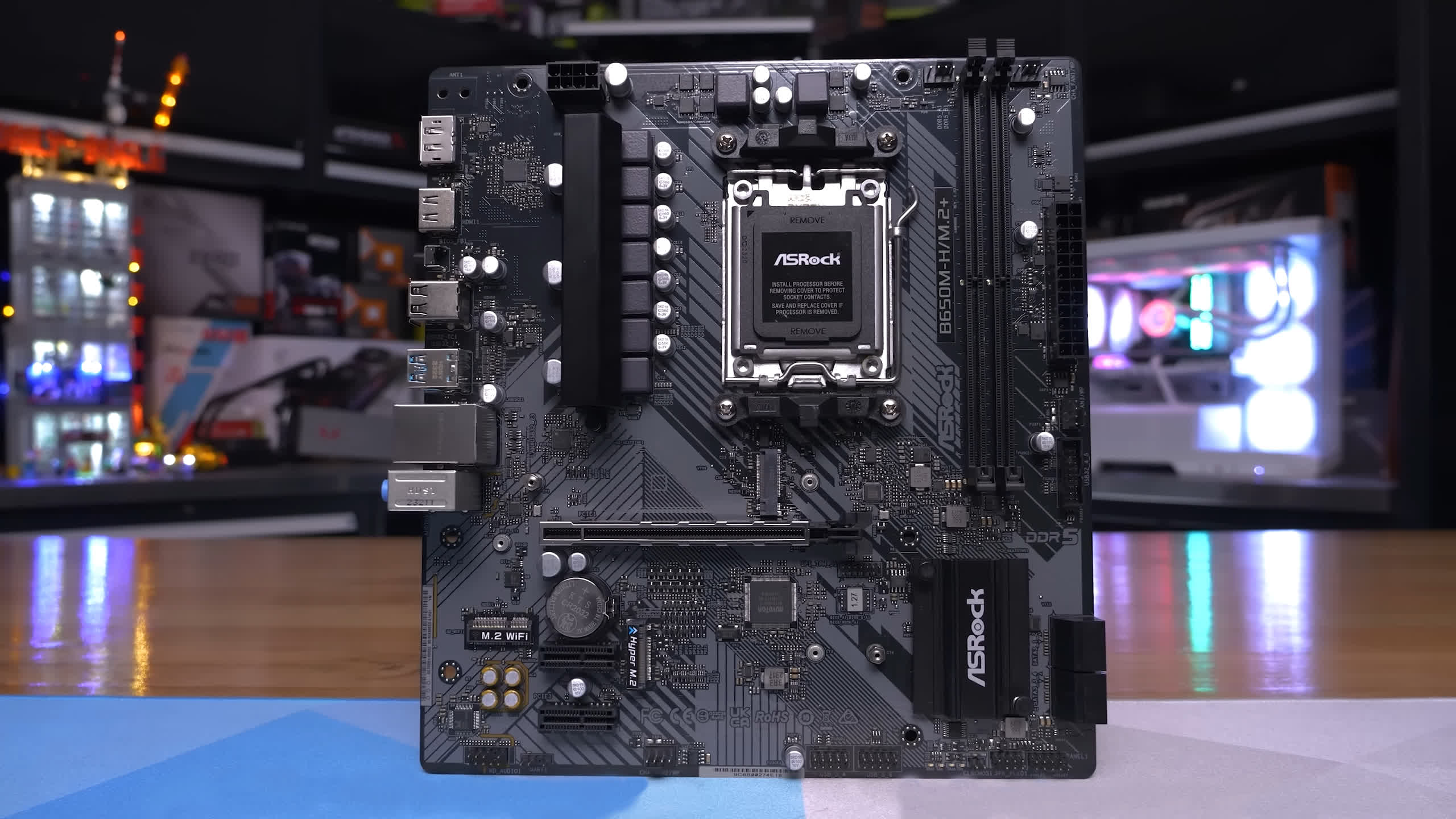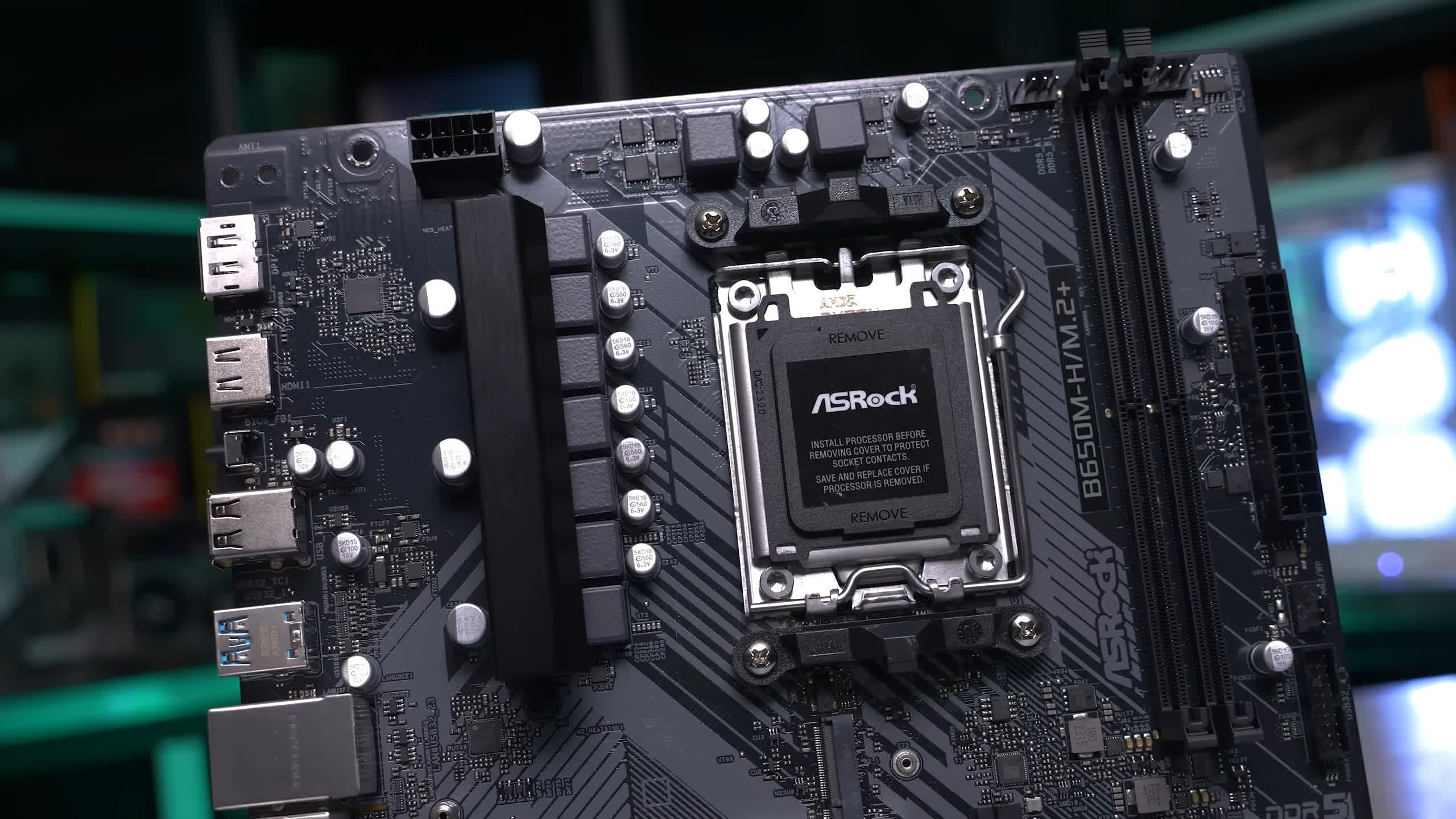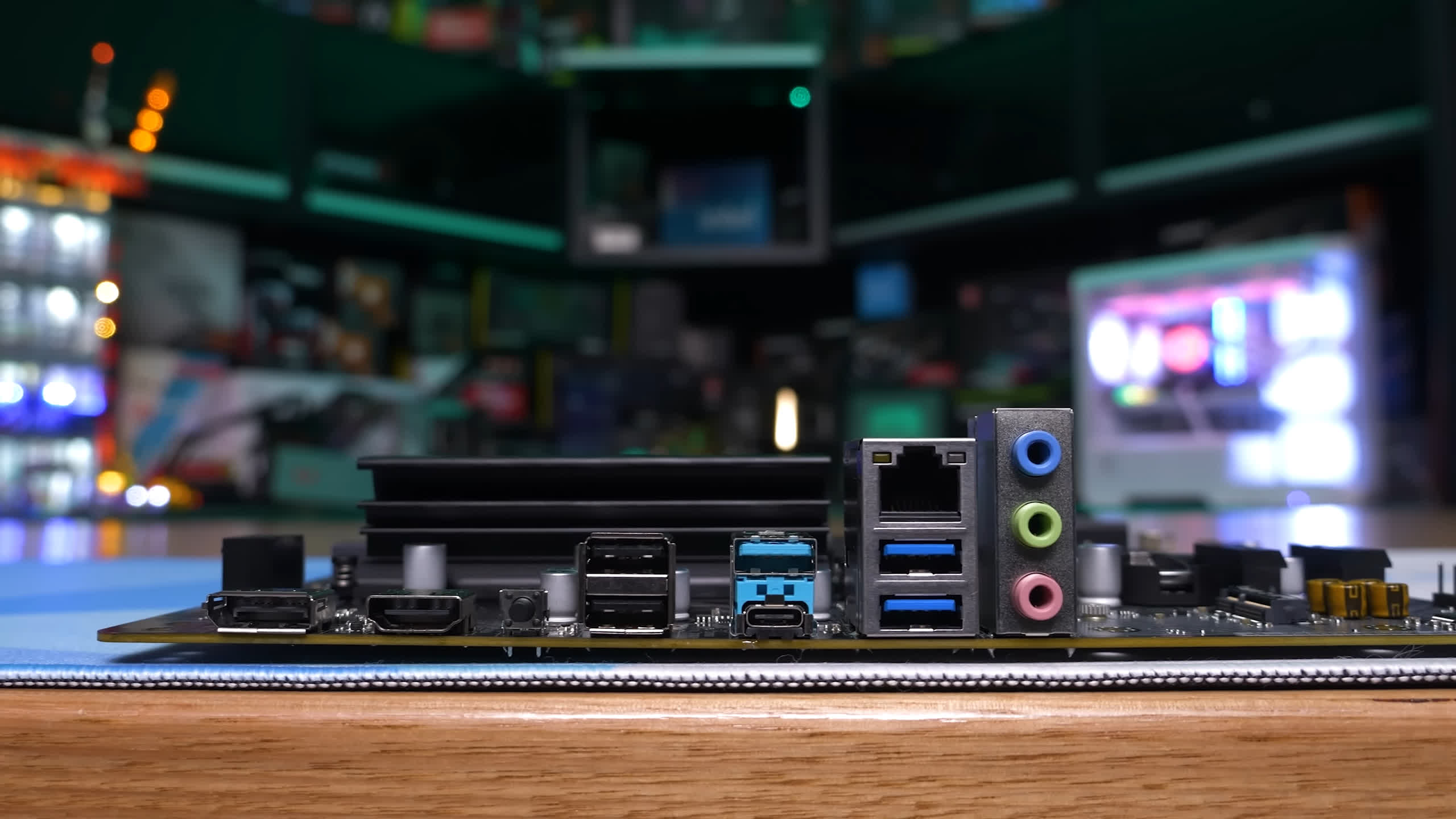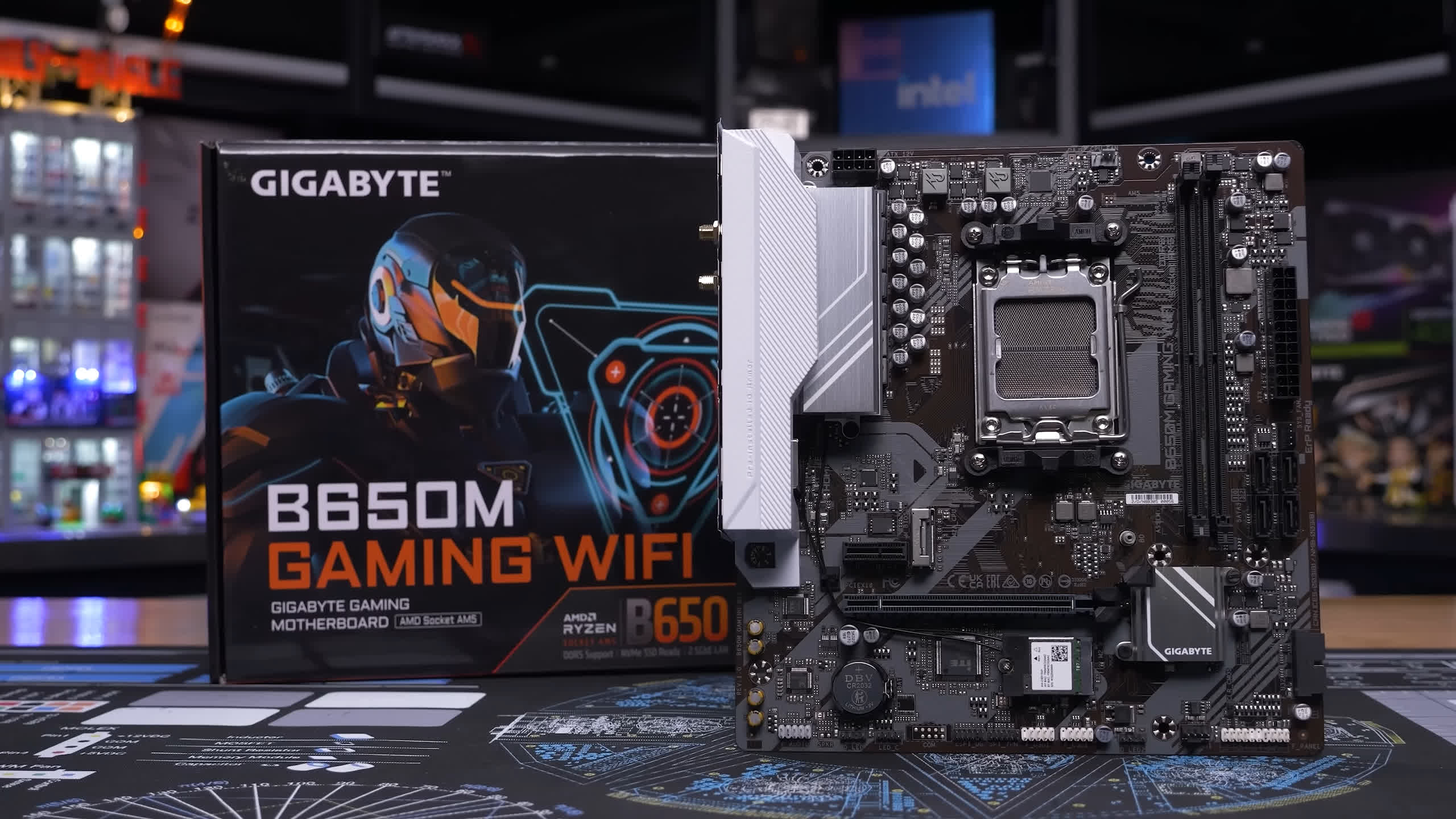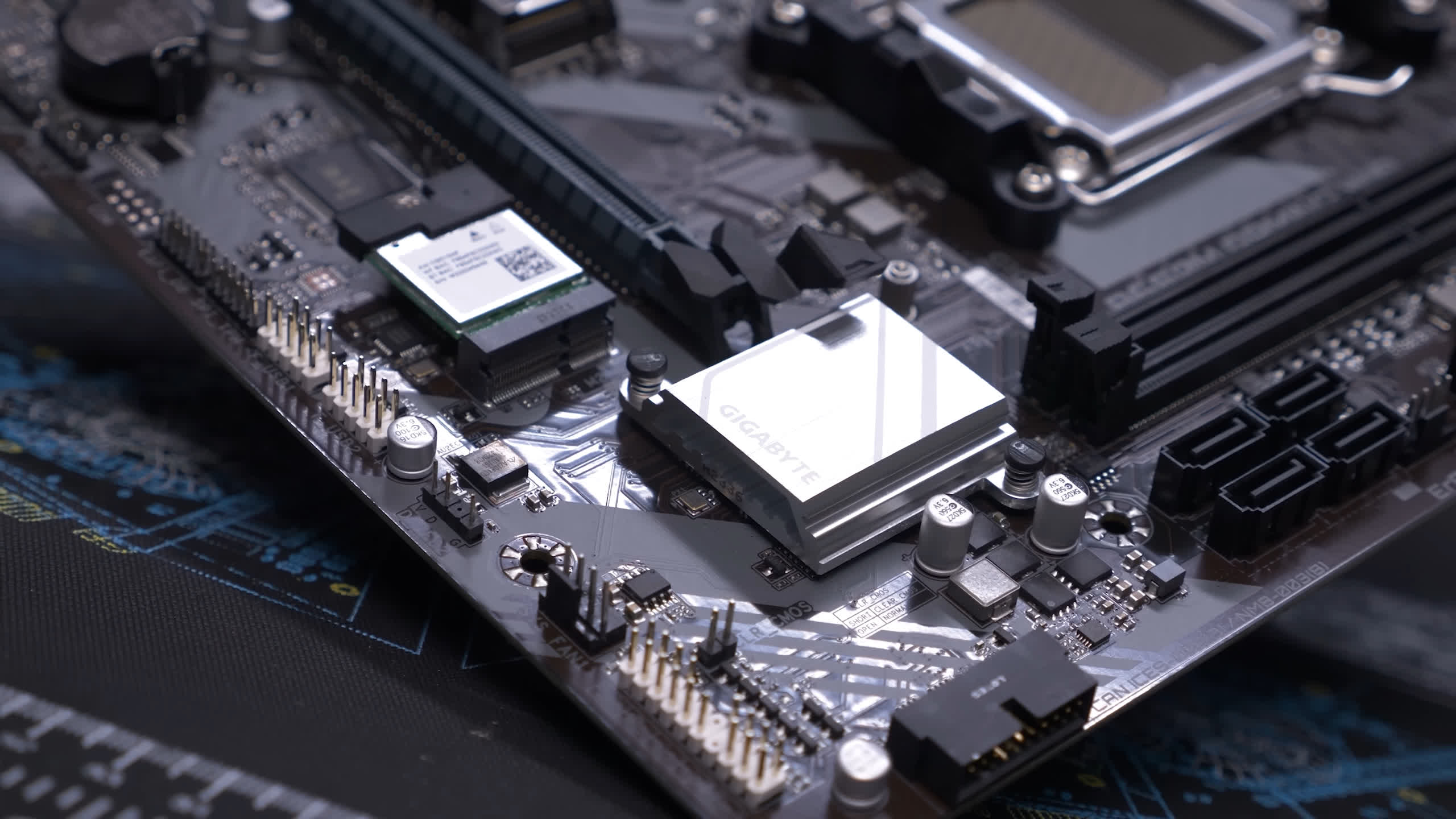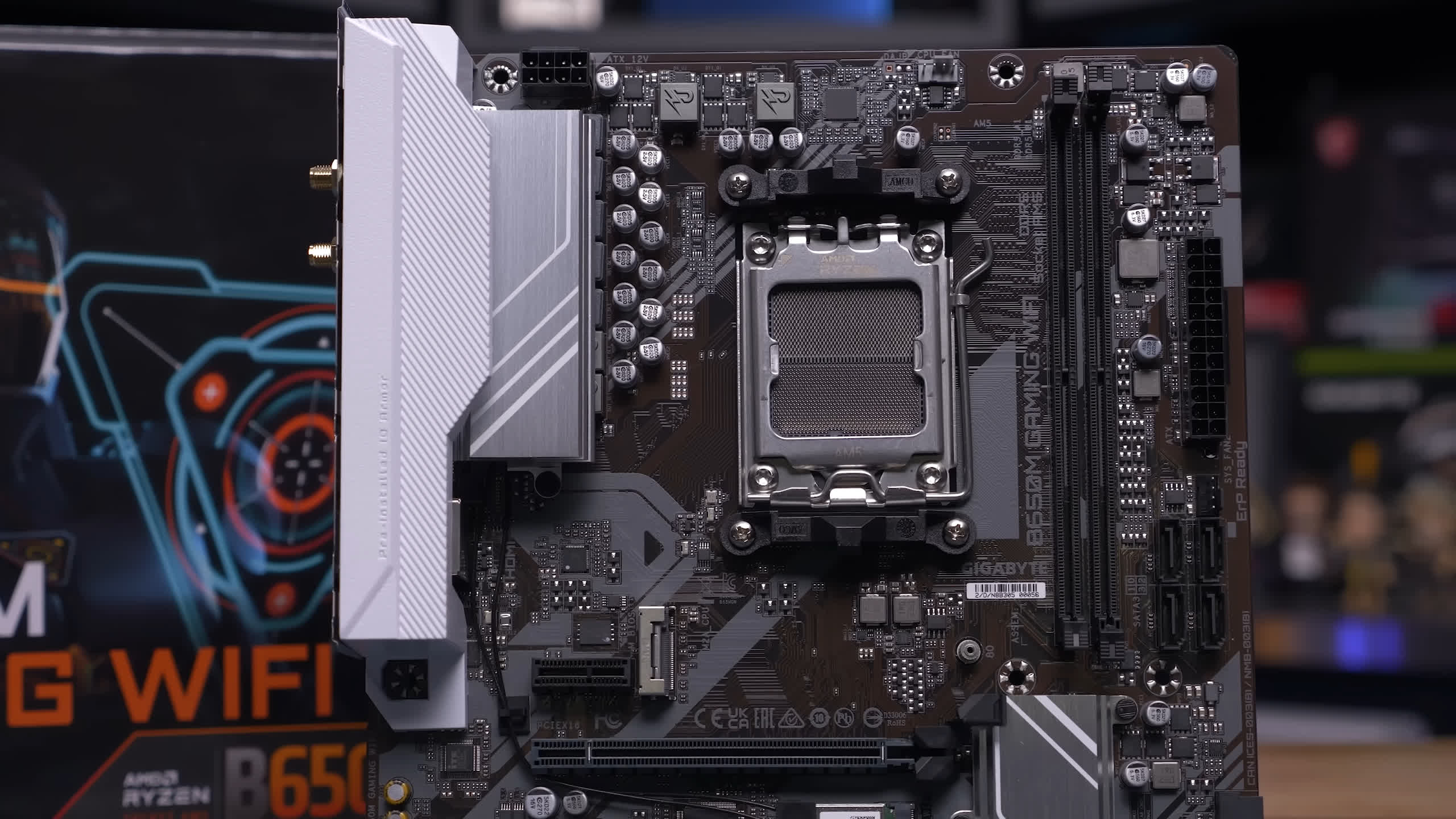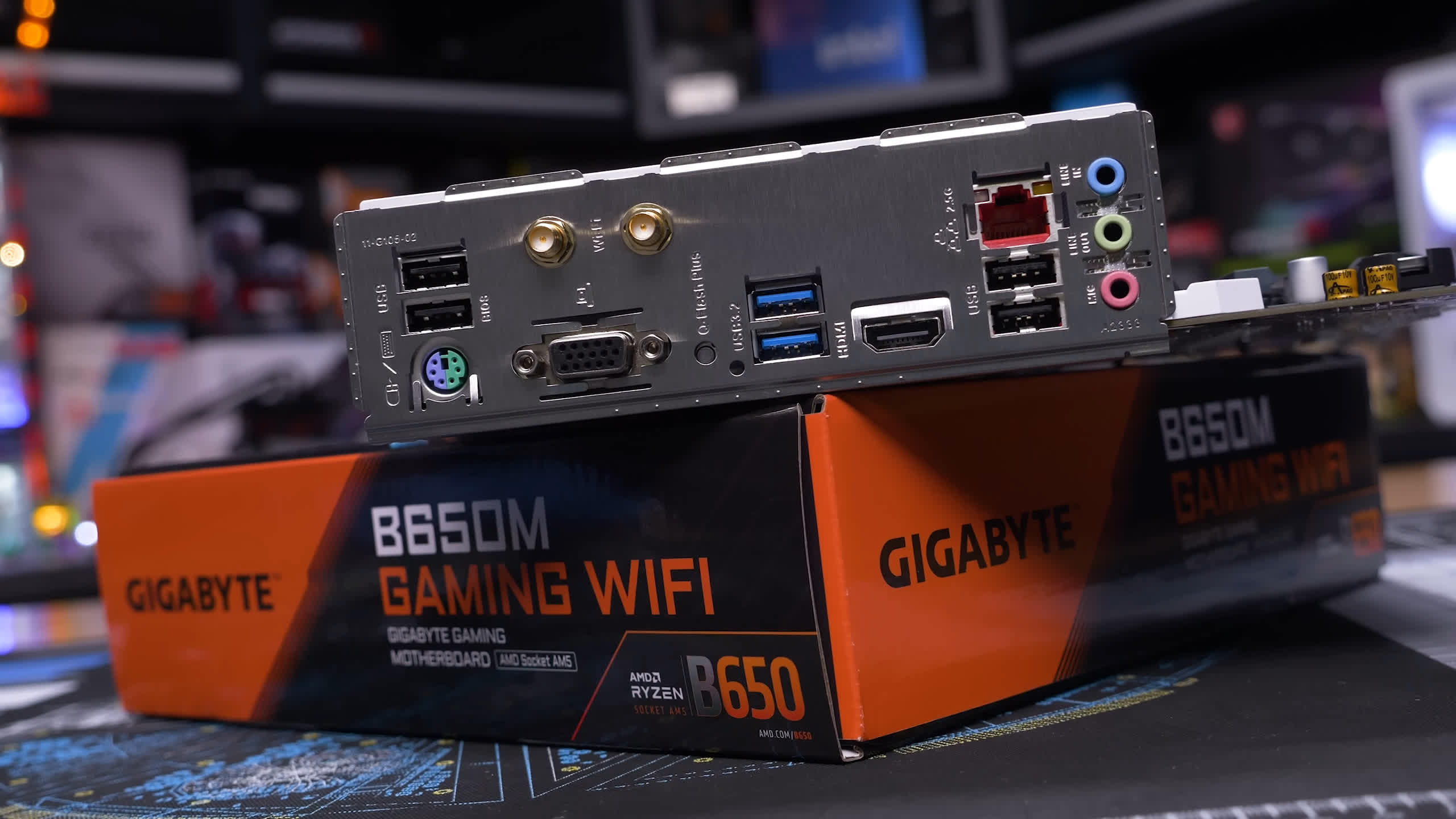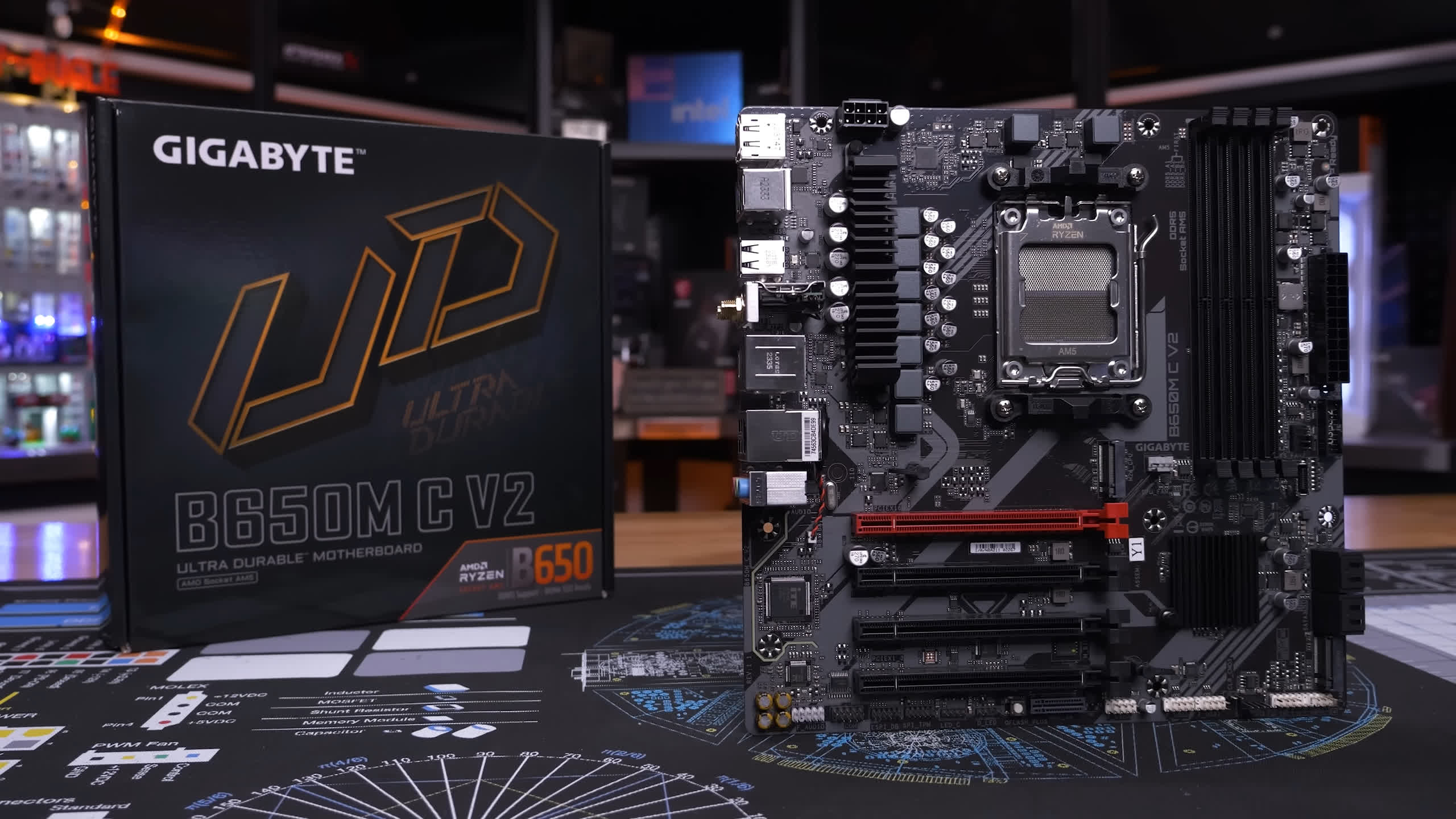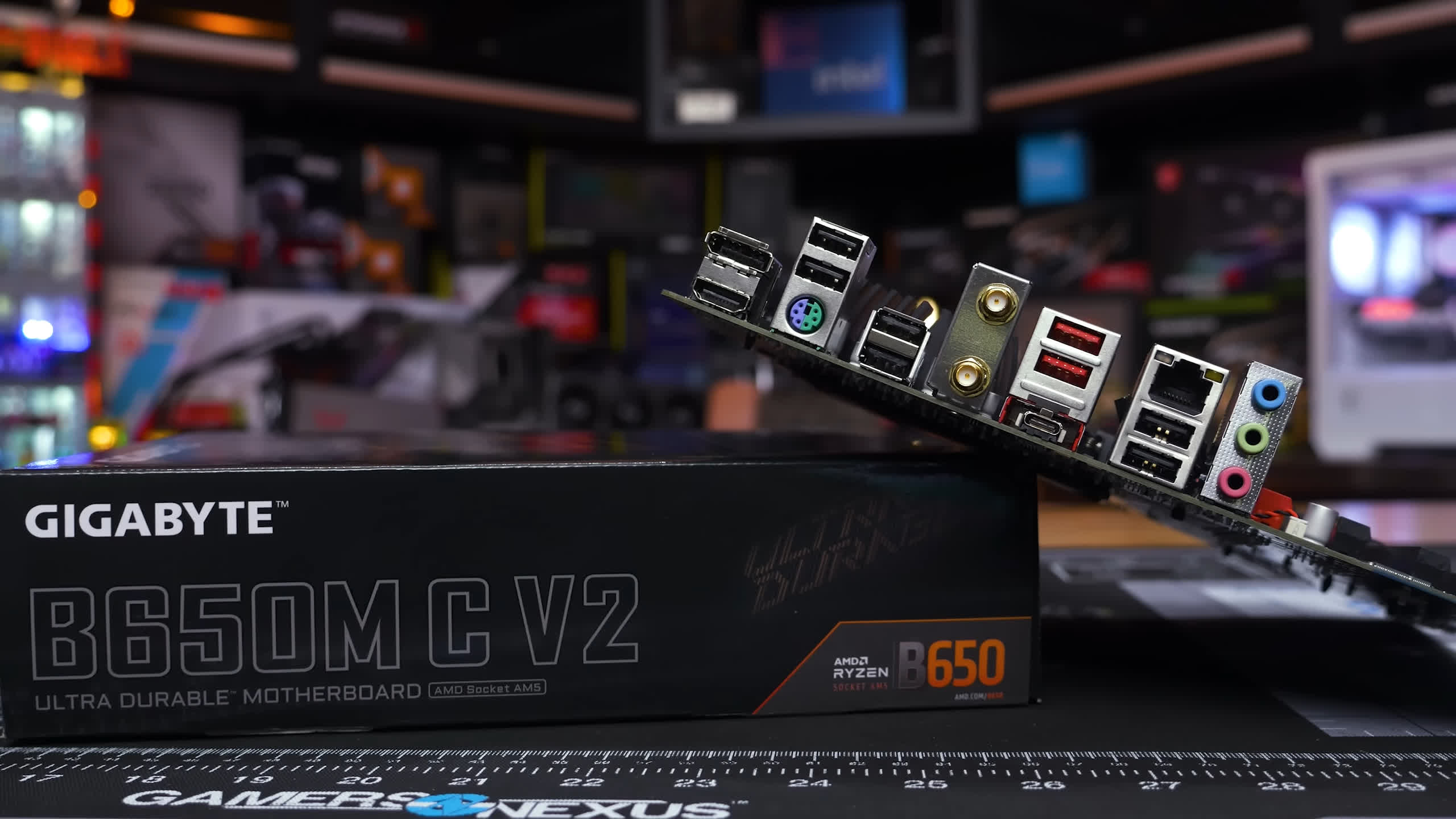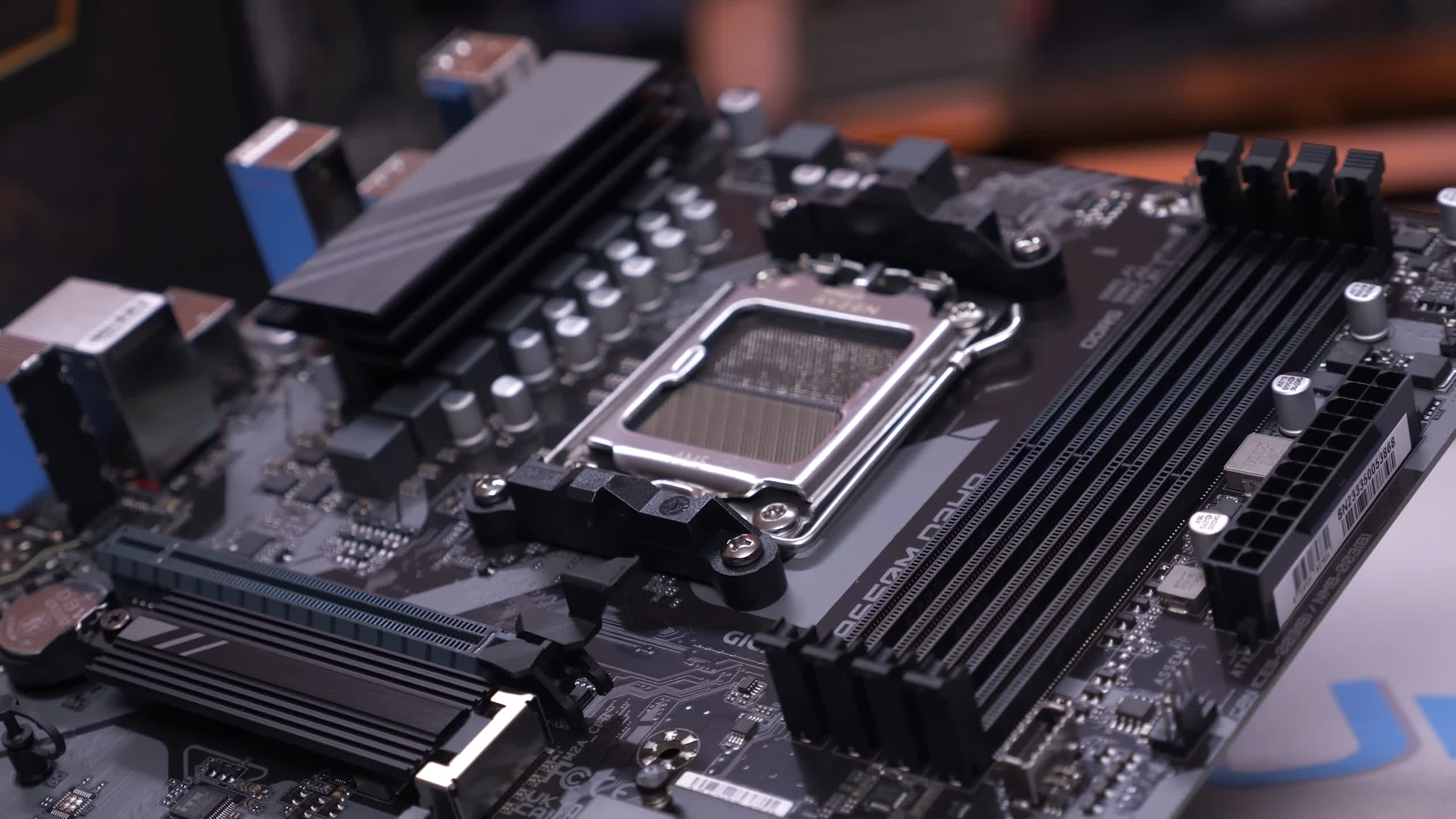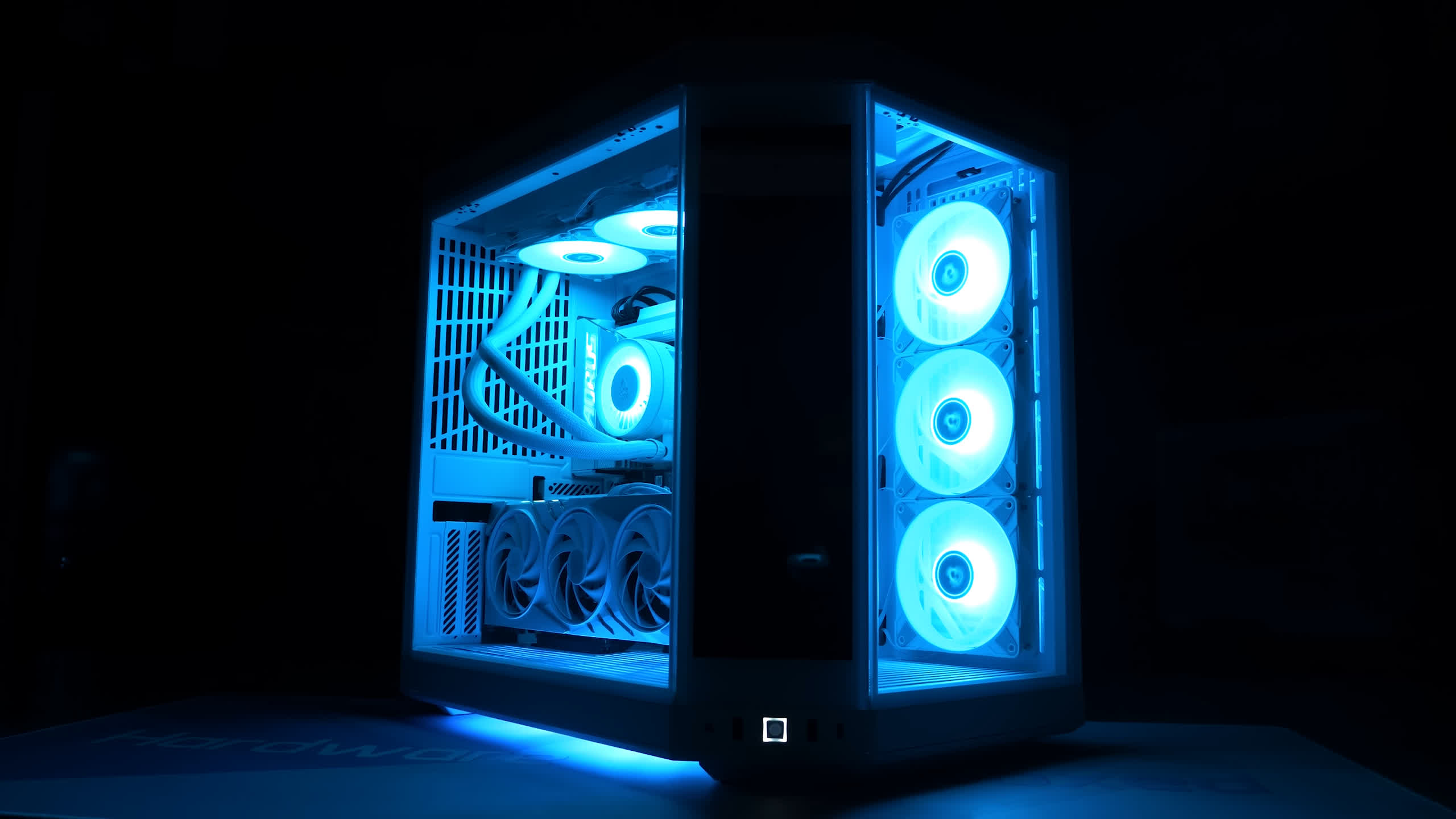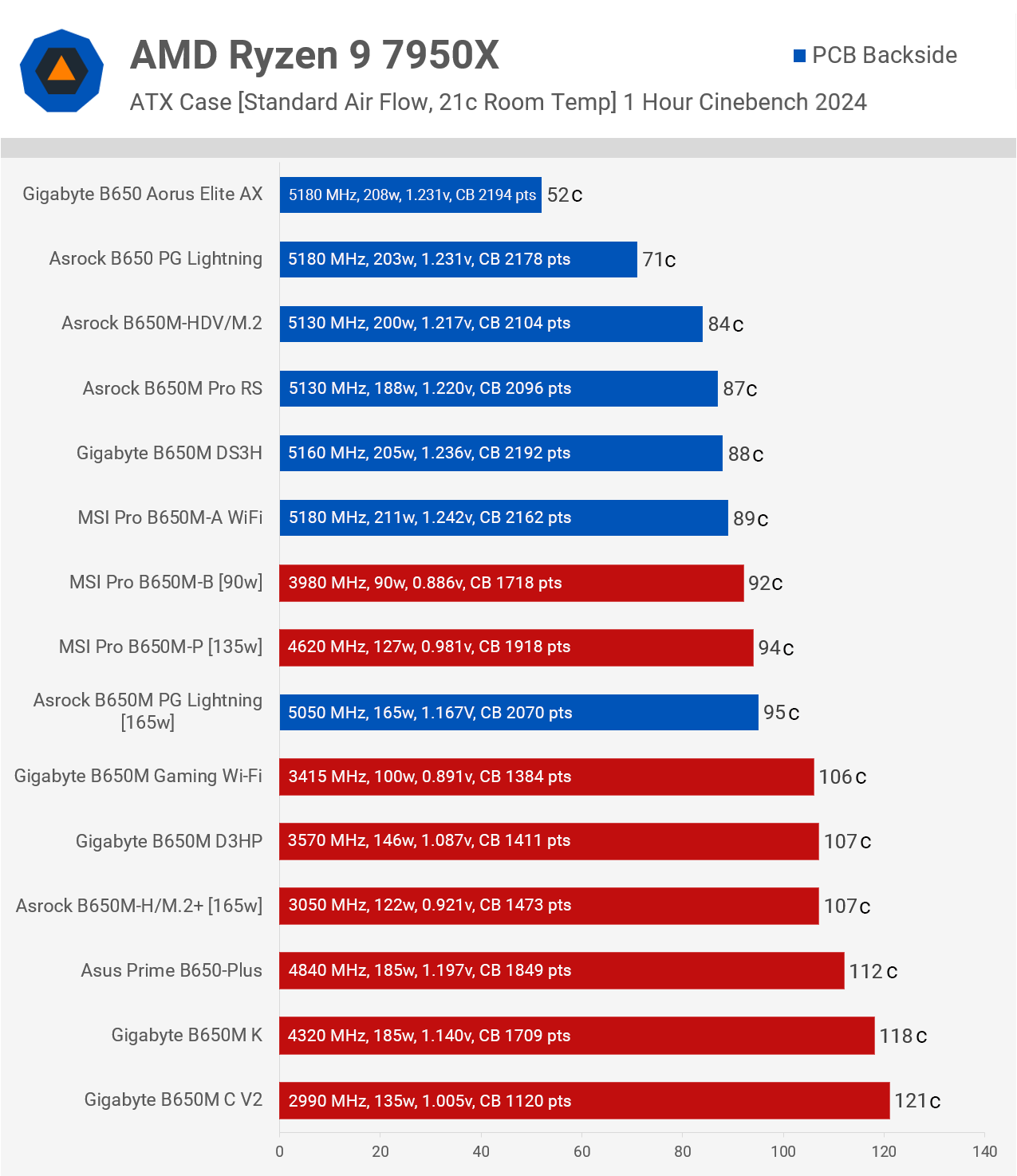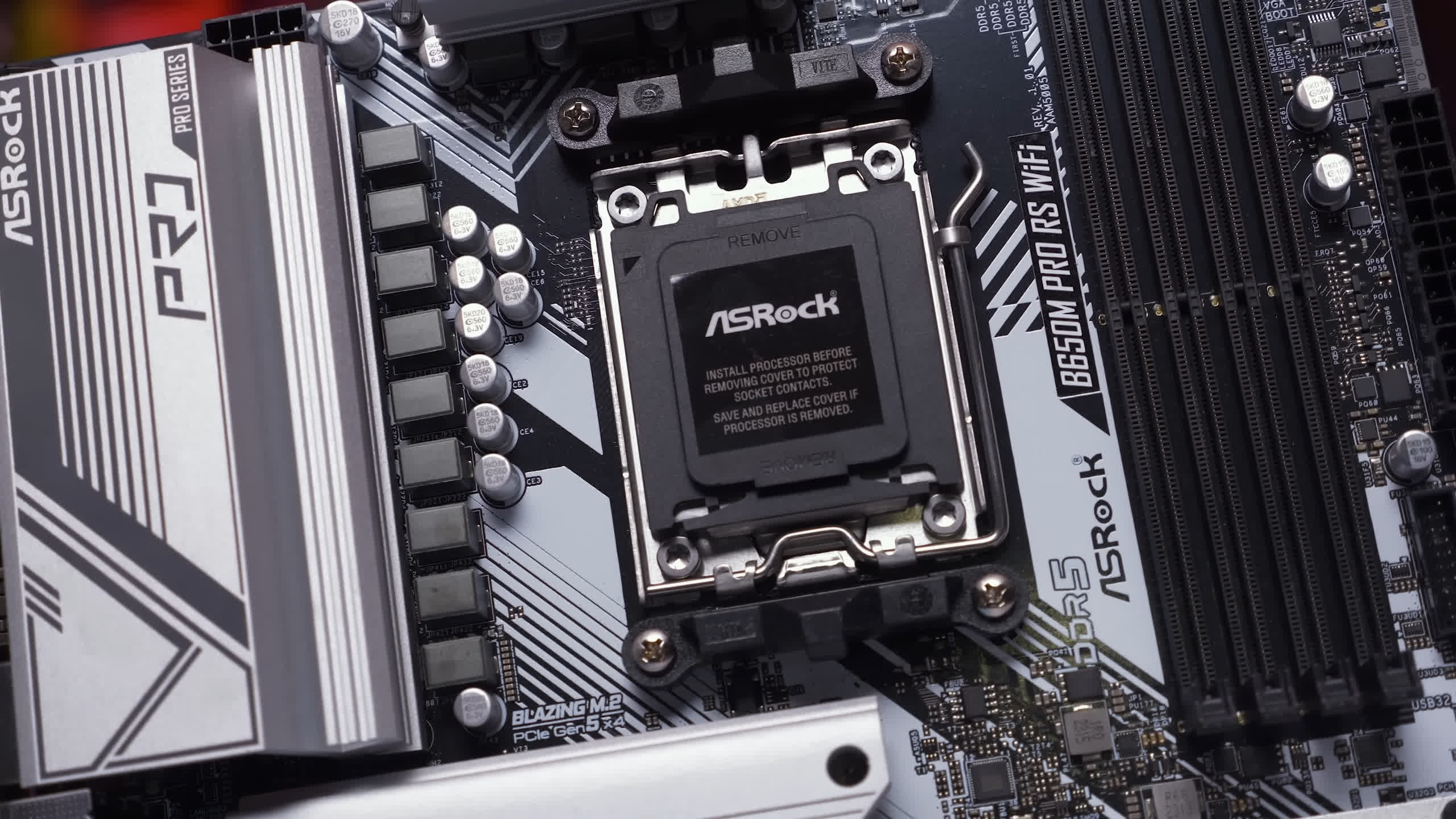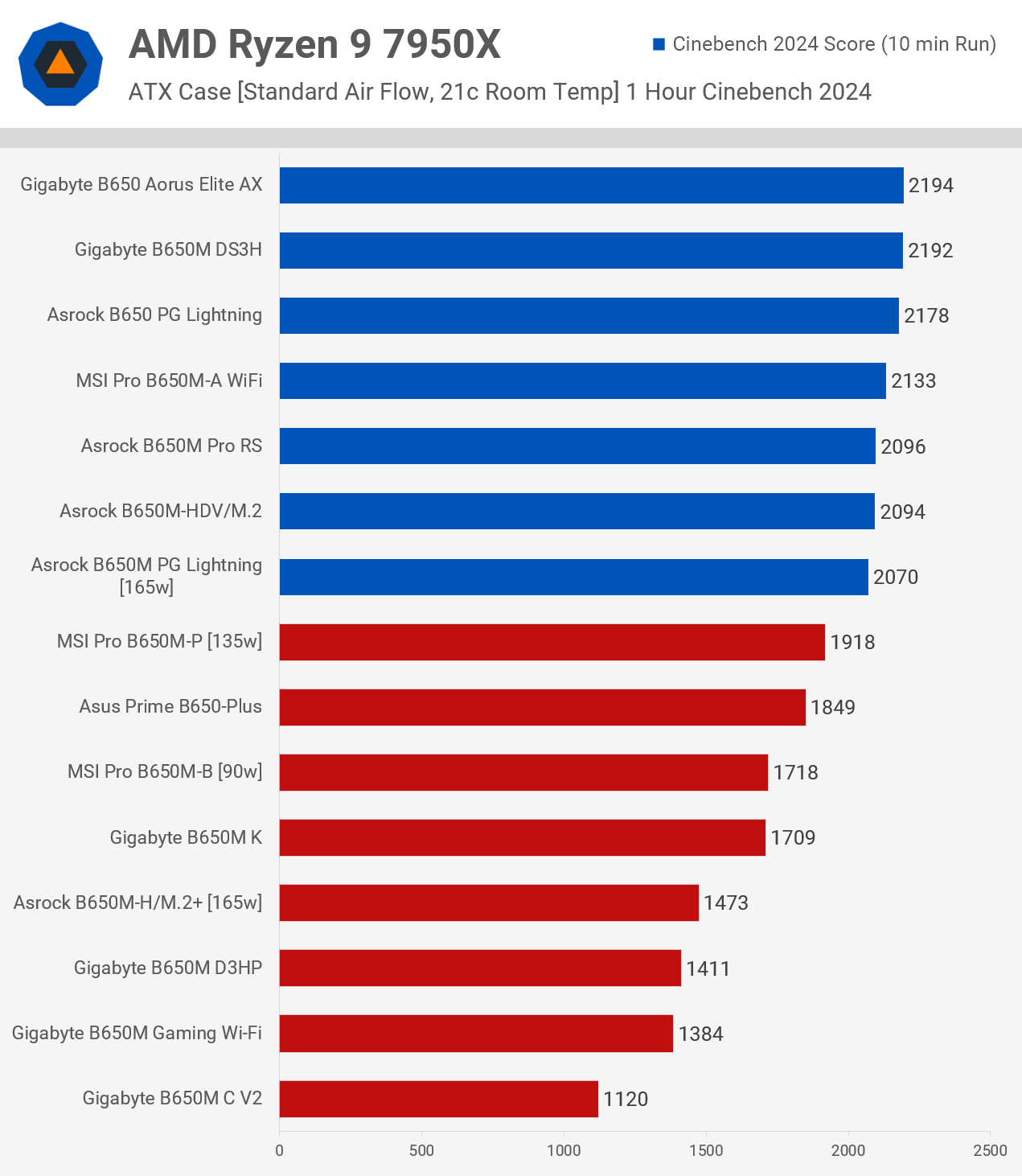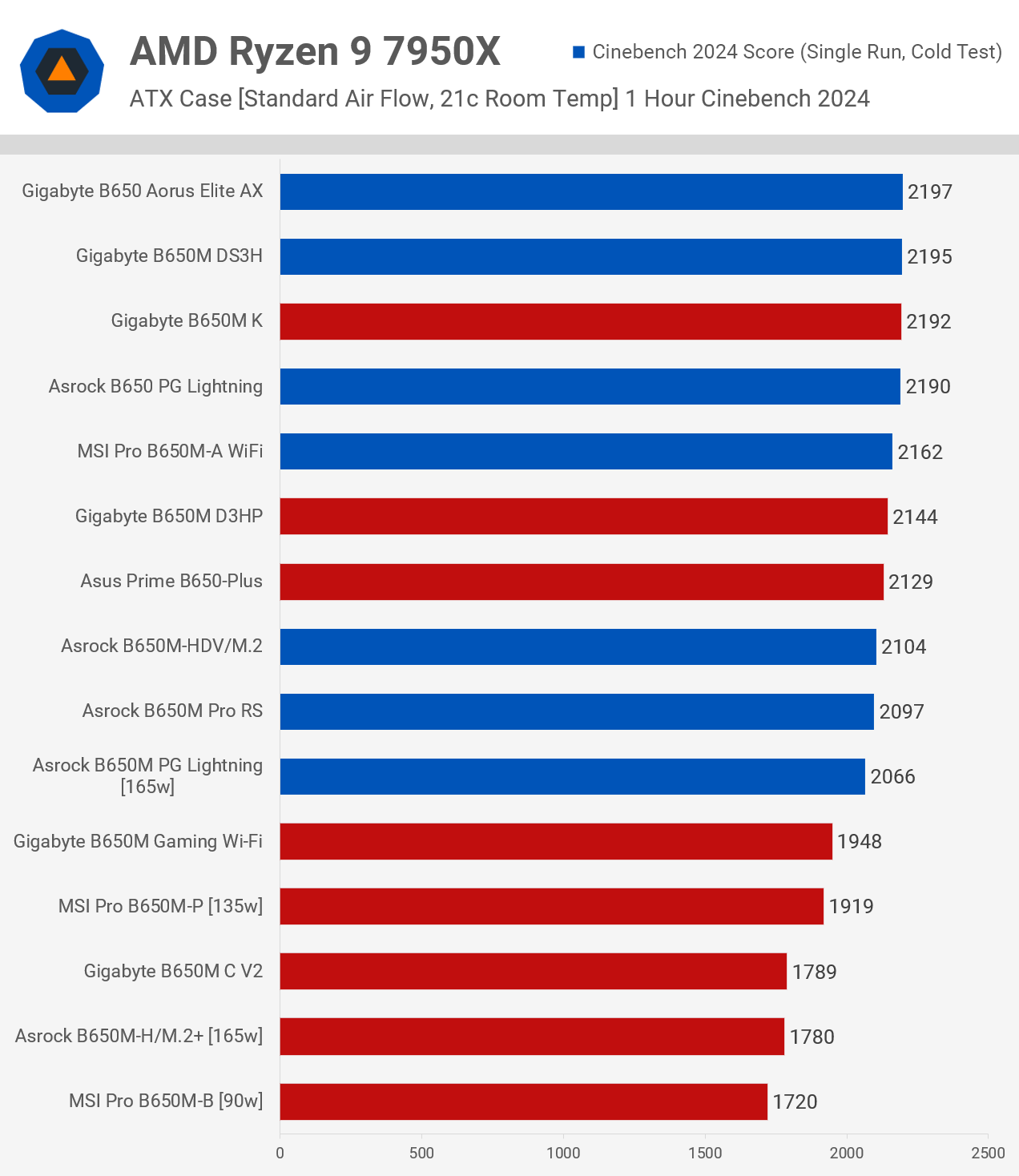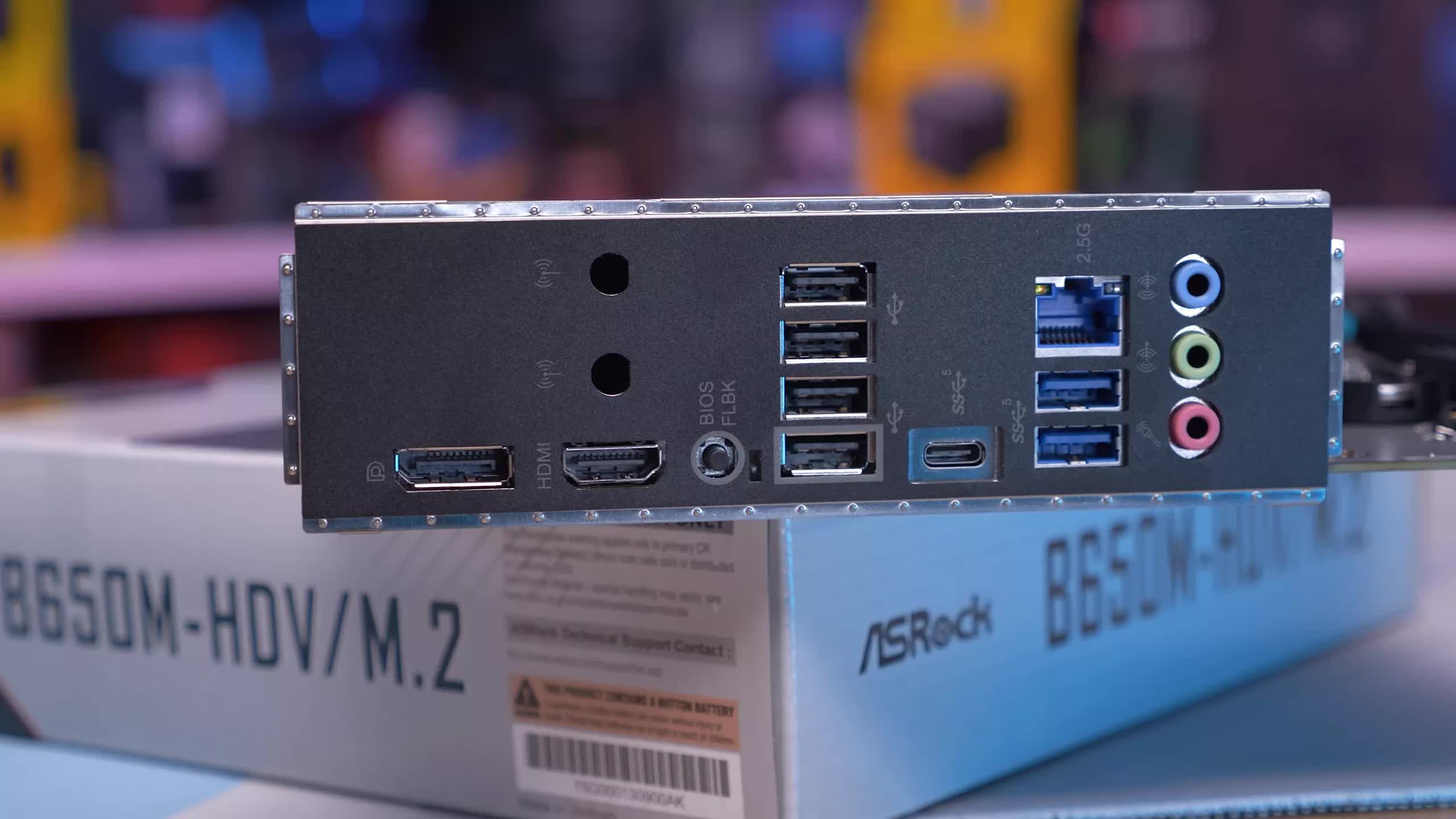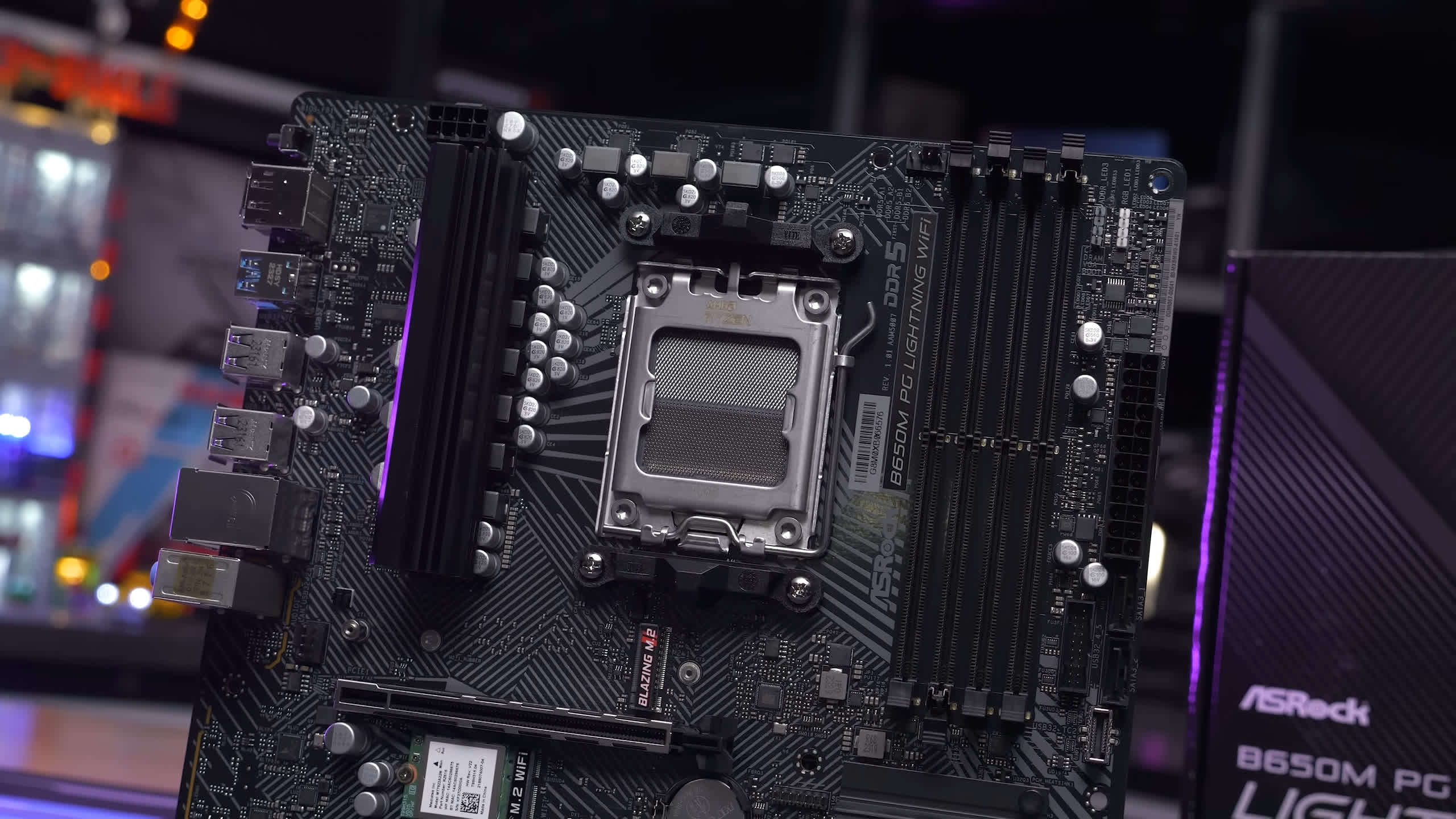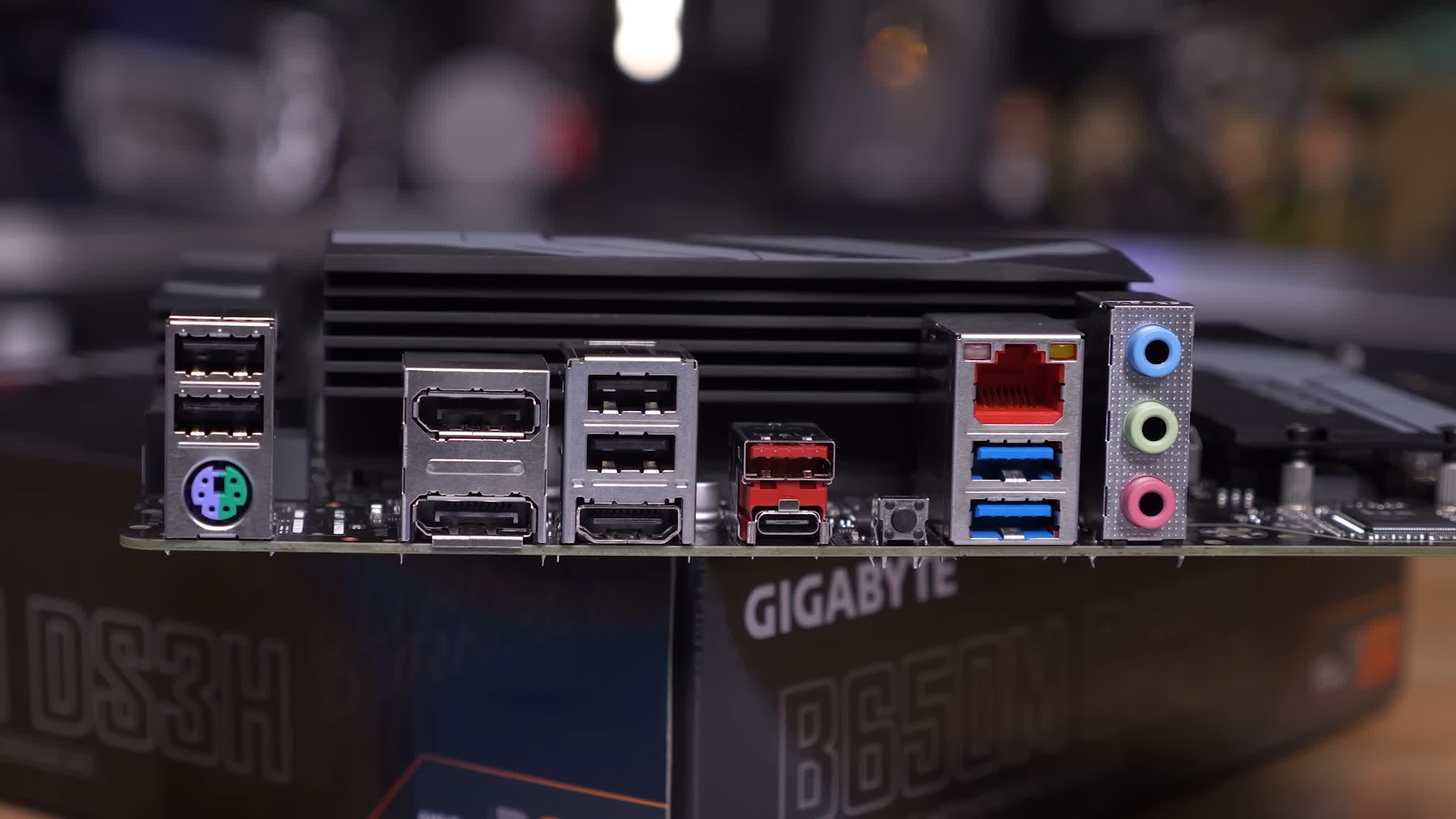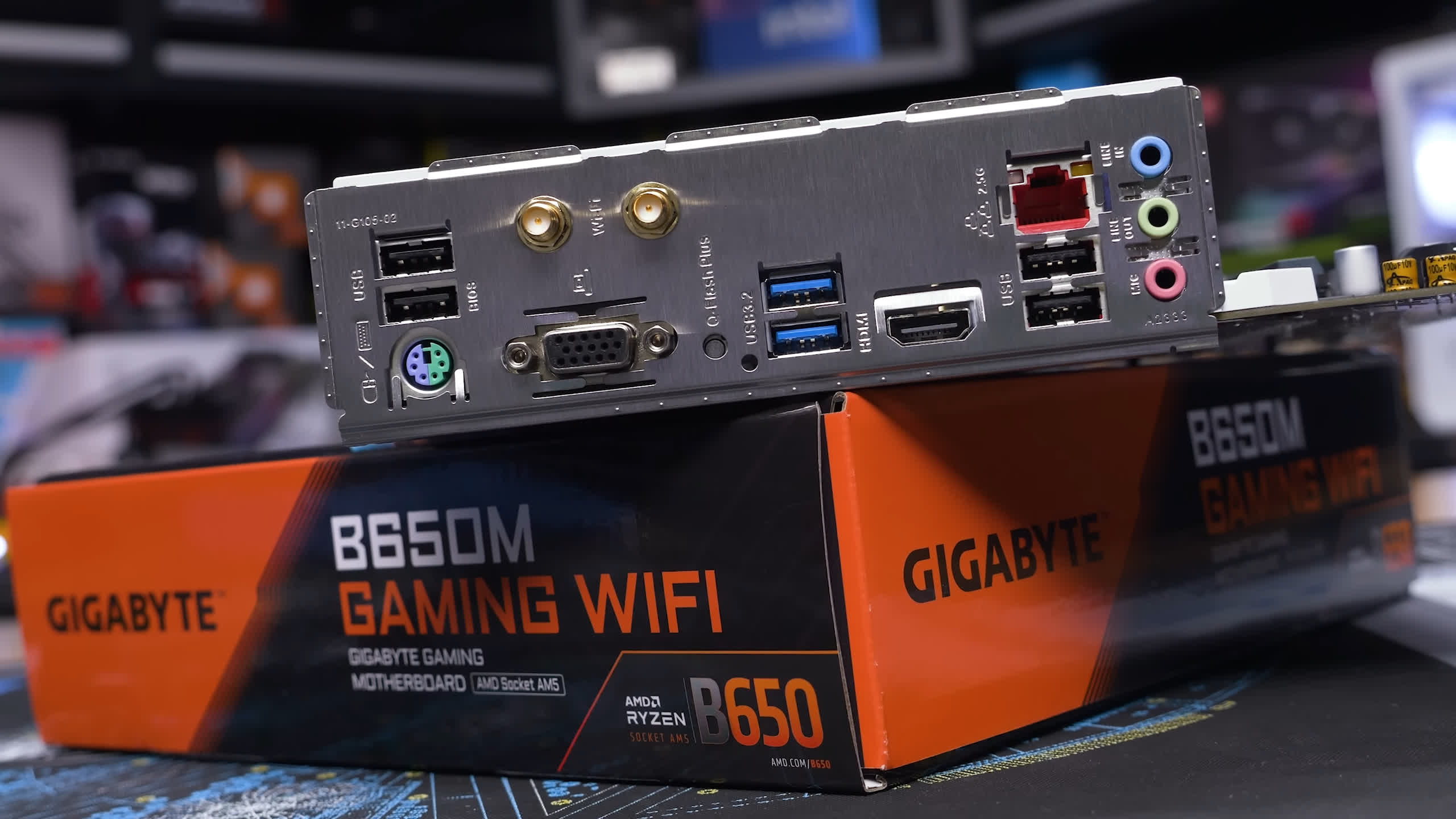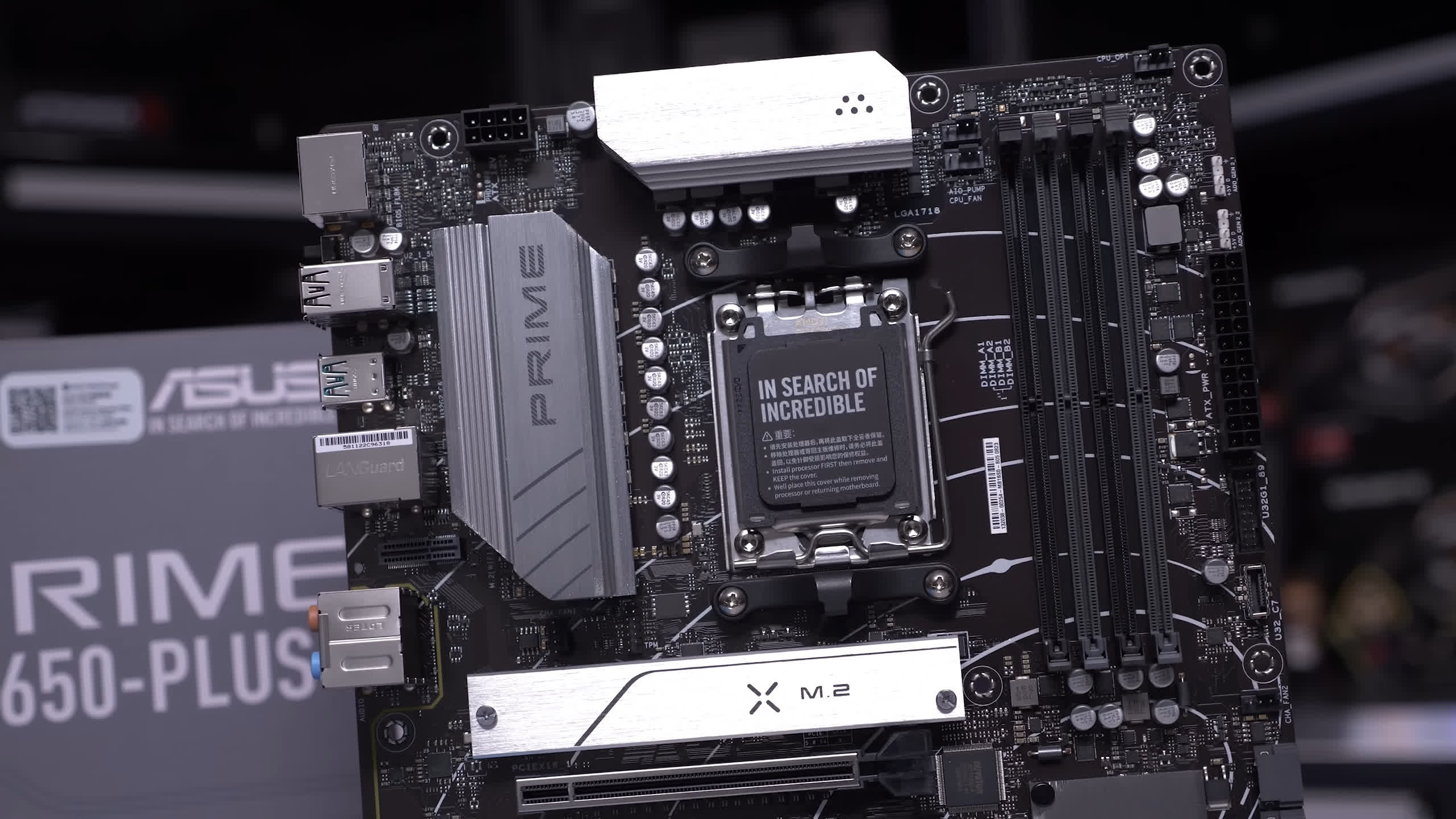About a year ago we put together a comprehensive roundup covering 35 motherboards based on the AMD B650 chipset, and at the time that was every single B650 board on the market. After months of work, we found that all B650 motherboards were fit for use with any AM5 processor, having tested them successfully with the Ryzen 9 7950X.
That's a big deal as it means you can invest in the AM5 platform with confidence – not something budget builders can do with Intel – as numerous LGA 1700 boards (12th-14th-gen Core) have been found to run excessively hot, often resulting in thermal throttling, and therefore lost performance.
The fact that you could go AM5 for your next build in the comfort of knowing any Ryzen CPU released for the platform will work, is nice. Or at least it was nice while it lasted. Recently we've noticed a few new entry-level AMD B650 boards popping up from the likes of MSI, Gigabyte, and Asrock, and some of them don't look to flash.
Now, this sort of thing isn't that unusual. Motherboard makers release updated boards or even revisions of existing models all the time. But what is unusual here is that all the new additions are entry-level budget models – and they've all been released rather quietly.
So we've gone about snapping up these new motherboards for testing, and some of the results are very disappointing...
MSI Pro B650M-P
We'll start with the new MSI Pro B650M-P, which currently costs just $120. That's considerably less than their previous entry-level model, the B650M-A WiFi which cost $160 when we wrote our original B650 roundup a year ago, and still costs the same amount today.
Compared to the more expensive 'A', the 'P' model appears to be a more budget-friendly option, featuring only a single, small VRM heatsink, fewer PCIe 4.0 slots, no WiFi, and fewer USB 3 ports on the I/O panel. However, it comes with a $40 discount, making these trade-offs seem reasonable.
But what about the VRM design? The 'A' model featured 8 55A power stages for the vcore, as highlighted on the product page. However, there is no such information for the new 'P' model. This is likely because the VRM on this new model is inferior, utilizing inexpensive discrete MOSFETs without doubling them up, resulting in weaker power delivery capabilities.
The vcore VRM consists of 6 phases using Sinopower SM4337 and SM4503 MOSFETs, a substantially weaker configuration compared to the 'A' model. We are not confident that it can adequately power a Ryzen 9 processor, although the CPU compatibility page on the MSI website does list support for the 7950X at 170 watts. We will be testing this claim shortly.
MSI Pro B650M-B
Also positioned below the 'A', the new MSI B650M-B model is intended to be more affordable than the 'P'. It is currently listed at a single retailer for $135. Given the board's specifications, this price seems incorrect. We would estimate it to be a $100-$110 model.
The 'B' model is one that we generally advise against as it lacks VRM heatsinks. Unlike higher-end models, this board definitely needs all the cooling support it can get due to its 6-phase vcore VRM using lower-quality discrete MOSFETs, specifically Alpha & Omega components, 36308 and 36303.
Moreover, you are only getting a single M.2 port and a single PCIe 3.0 x1 slot, along with the standard PCIe 4.0 x16 slot. While it's a very basic motherboard, the inadequate VRM configuration likely poses a significant drawback. MSI claims on their compatibility page that this model will support the Ryzen 9 7950X with a stated wattage of 170 watts, but this could be misleading as it likely only reflects the official TDP.
Asrock B650M Pro RS
From Asrock we have the B650M Pro RS, and we thought we'd already tested this board as we've looked at the excellent B650 Pro RS which is the ATX version, which packs 14 60A power stages for the vcore VRM and costs $150.
The MicroATX version, though, priced slightly less at $135, doesn't feature 14 60A power stages for the vcore portion of the VRM; instead, it has been downgraded to 8 50A power stages. This is still functional, but it represents a significant downgrade.
Aside from that, the boards are fairly similar; the configuration of the I/O panel is very similar. The MicroATX model drops a PCIe slot, which makes sense. Audio and networking remain the same, you still get three M.2 slots, and USB support is much the same. Additionally, there is a good amount of heatsink coverage on the board. Overall, it is a decent-looking board that should perform quite well.
Asrock B650M PG Lightning
Then we have the B650M PG Lightning from Asrock, and we're unsure how we feel about this one, mostly because we don't yet know the pricing.
The ATX model, the B650 PG Lightning, packs 14 60A power stages for the vcore and performs exceptionally well. However, the MicroATX version is equipped with just 6 50A power stages, which is a substantial downgrade for a board sharing the same name.
The ATX version is a $200 board, and we expect the MicroATX model to be priced closer to $100. Nonetheless, it's a little dodgy to give two very different products almost identical names. We're not sure how the B650M PG Lightning will handle the Ryzen 9 7950X; we suspect it might struggle but should perform better than some of the other budget boards in this roundup.
Asrock B650M-H/M.2+
A favorite of ours when it comes to budget-friendly B650 motherboards is the Asrock B650M-HDV/M.2, featuring 8 50A power stages for the vcore and priced at $120. So, when we learned there was a B650M-H/M.2+ priced at just $100, we were keen to check it out.
This model features the same 6 50A power stage vcore VRM as the B650M PG Lightning but with fewer capacitors and cheaper inductors. The heatsink is also larger on the Lightning and is secured using screws rather than plastic clips. Additionally, it includes thermal pads over the inductors, which will help reduce how much heat is dumped into the PCB, so performance here will likely vary.
Compared to the HDV, the 'H' does not look nearly as appealing. The heatsink on the VRM is much smaller, and the HDV also provides full VRM coverage along with a heatsink for the M.2 slot. The HDV comes with a pre-installed I/O shield and supports 2.5 Gbit LAN, whereas the 'H' is limited to Gigabit. You also get 16 USB ports with the HDV, whereas the 'H' is limited to 12, and the second PCIe x1 slot is full-length on the HDV. Thus, for just $20 more, the HDV is a significantly better product.
Gigabyte B650M Gaming Wi-Fi
Now, for the Gigabyte boards, one new model that piqued our interest was the B650M Gaming Wi-Fi, which is currently only being sold at PC Case Gear in Australia. It's the cheapest B650 board they're selling at $180 AUD, making it one of the most affordable B650 boards available down under.
In the US, however, it has yet to go on sale, so we have no idea what it will cost for our US readers. Based on pricing here, it should be around $140, and it's a decent-looking board for that price. Plus, it has 'Gaming' in the name, so how could you go wrong?
But in all seriousness, despite Gigabyte's claims of "Unparalleled Performance" with a 5+2+2 Phases Digital VRM solution, it is very low-tier, so you'll want to avoid it. The vcore portion of the VRM features just 5 phases using On-Semi 4C10N and 4C06N discrete MOSFETs, which isn't going to be enough to power Ryzen 9 processors, or anything that uses much over 100 watts.
You're also getting just two USB 3.2 Gen 1 ports on the I/O panel, while the other four USB ports are the 2.0 spec. There's a single M.2 port, two DIMM slots, and just a single PCIe 3.0 x1 slot complementing the standard PCIe 4.0 x16 slot. It's an extremely basic motherboard that, in some ways, lacks the basics like storage expansion, for example.
Gigabyte B650M C V2
Another new Gigabyte B650 board is the B650M C V2, and we're not entirely sure who this model is designed for, but surely one of you will know. Anyway, this unusual-looking board drops the standard 2.5 Gbit LAN found on basically every other B650 board for old-school Gigabit LAN. You also get a slower WiFi 802.11ac solution supporting transfer speeds of up to 433 Mbps.
Interestingly, there are four PCIe x16 slots in total, though only the primary slot connected to the CPU is wired for x16 bandwidth using the 4.0 spec. The other three x16 length slots are only wired for x1 bandwidth using the PCIe 3.0 spec.
For storage, there's a pair of M.2 slots, one supporting PCIe 4.0 x4 while the other is PCIe 3.0 x2. Then there is a third M.2 but it vertically mounts for some reason and only supports PCIe 3.0 x1, so it's going to be of very limited usefulness.
The I/O also kind of disappoints; it's mostly loaded with USB 2.0 ports, six in total, with just a single USB Type-C 3.2 Gen 1 port and two USB 3.2 Gen 2 Type-A ports.
Compared to the B650M Gaming Wi-Fi, you're again getting a 5-phase vcore, but this time with doubled-up On-Semi 4C06N low-side MOSFETs, though just a single high-side 4C10N is used per phase. So a better VRM here, but it's still not great, and you only get a small heatsink.
Gigabyte B650M K
Yet another cheap Gigabyte B650 board is the B650M K, and this one has been on the market for some time now and can currently be had for just $125.
At first glance, this one looks a lot better than the two models we've already looked at. Gigabyte claims an 8-phase vcore VRM, there are four DIMM slots, but just two M.2s and a single PCIe x1 slot complementing the standard PCIe 4.0 x16 slot connected to the CPU.
The I/O panel features just two USB 3.2 Gen 1 ports with two 3.2 Gen 2 ports, one of which is a Type C. You do get 2.5 Gbit LAN, but there's no WiFi option. As for the vcore VRM, it's 4-phases using doublers with an On-Semi 4C06N low-side MOSFET and a 4C10N on the high-side, offering three more MOSFET pairs than the B650M Gaming Wi-Fi.
If the K does indeed end up being cheaper than the B650M Gaming Wi-Fi, then we're not entirely sure why Gigabyte released that board, other than for 'money', making it a rather obvious cash grab.
Gigabyte B650M D3HP
Finally, we have the B650M D3HP, which appears remarkably similar to the B650M K, and the price is also very similar at $120. When compared to the K, the Q-Flash Plus button on the I/O panel has been removed, and there are no USB 3.2 Gen 2 ports, just four 3.2 Gen 1 ports. There are still two M.2 slots, but the secondary slot connects to the chipset and still supports the PCIe 4.0 x4 interface.
The VRM has also been downgraded to 5 phases for the vcore, which is the same configuration seen on the B650M C V2. Here, we have doubled-up On-Semi 4C06N low-side MOSFETs, with a single high-side 4C10N per phase. It's not a great-looking board, and for $120, we suspect there are better B650 options, so let's get into the test results.
VRM Temperatures
For testing we're using the Hyte Y70 Touch tempered glass mid-tower case and for cooling the Arctic Liquid Freezer III 360mm ARGB AIO. Then, for recording temperatures, we're using a digital thermometer with K-Type thermocouples, and we'll be reporting the peak PCB temperature.
We're not reporting Delta T over Ambient; instead, we maintain a room temperature of 21 degrees and ensure a consistent ambient temperature with a thermocouple positioned next to the test system.
As for the stress test, we're using the Ryzen 9 7950X and for the load, Cinebench 2024, which was looped for an hour, at which point we're reporting the maximum PCB temperature, again recorded using K-type thermocouples. These results aren't comparable with past B650 results for multiple reasons, including the use of the latest AGESA code, new hardware with the case and cooling, and updated software for creating load. So let's get into the results…
Added as a reference point, we have the Gigabyte B650 Aorus Elite AX, a $200 board that performs very well, as a $200 board should. We also have the Gigabyte B650M DS3H and MSI B650M-A WiFi, which were among the best value entry-level models from our previous testing and today cost $150. Then, of course, we have the Asrock B650M-HDV/M.2, which still costs $120 and is the best value entry-level board in our opinion.
As you can see below, the B650M-HDV/M.2 peaked at 84°C and passed our stress test with flying colors, keeping the 7950X clocked at over 5.1 GHz for a 200w load and scoring a neat 2014 pts after a 10-minute loop test. Consider this the benchmark for budget B650 boards.
The new MSI models failed miserably. The B650M-B is limited to a package power of just 90w while the B650M-P isn't much better at 135w. Even with a lot of voltage reduced from the 7950X, these boards still ran at over 90°C, and with strict power limitations, heavily throttled the Ryzen 9 part. The B650M-B saw an average clock frequency of just 3,980 MHz for a score of just 1,718 pts while the higher power limit of the B650M-P allowed for an average clock frequency of 4,620 MHz, boosting the score to 1,918 pts.
This means a part like the 7950X will run over 20% faster on a board like the B650M-HDV/M.2 when compared to the B650M-B and 10% faster than the B650M-P. Thus, the MSI boards are disappointing given they cost the same amount, or more, than the HDV.
Now the Asrock B650M PG Lightning has a 165w power limit in place, but with some decent voltage tuning, it still produced reasonable results, despite running at 95°C. We've given it a pass here, though you could technically fail it given the operating frequency was reduced to 5,050 MHz, about a 2% reduction when compared to unrestricted boards. It's certainly not a good product, and we're not fans of this model sharing its name with the significantly better ATX version, which ran without power limits and saw a peak VRM temperature of 71°C.
Next, we have the Gigabyte B650M Gaming WiFi and, like the new budget MSI boards, this one is truly awful. After an hour of load, running the 7950X is throttled down to 100 watts where it produced a score of just 1,384 pts thanks to an average clock frequency of just 3,415 MHz. To put that into perspective, if you purchased the B650M DS3H rather than the Gaming WiFi, you'd be looking at almost 60% greater all-core performance with the 16-core Ryzen processor.
Meanwhile, the B650M D3HP wasn't much better, averaging 146w for a frequency of 3,570 MHz, and that resulted in a score of just 1,411 fps. The newest budget board from Asrock also disappointed, the B650M-H/M.2+ features a 165w limit but that turned out to be a non-issue given the board could only average 122w during our test, resulting in an average frequency of just 3,050 MHz and a score of 1,473 pts.
Now that score is higher than the D3HP despite a much lower average clock frequency, and this is because these boards handle throttling differently, so the results won't scale in a linear fashion and instead tend to end up a bit all over the place. It really depends on how broken the board is under these conditions and how it handles being broken. Some gently ease the frequency down while others will bounce between the maximum frequency they can handle at a given time while throttling as low as 544 MHz for a quick break.
The Asus Prime B650-Plus failed our test previously, running at over 100°C. This updated test saw the board hit 112°C, resulting in some throttling for an average frequency of 4,840 MHz and a score of 1,849 fps, so not good, but much better than most of the budget boards we've seen so far. Still, Asus has done so poorly with their B650 range that you have to spend $190 to get a board that works well, and that example would be the TUF Gaming B650-E WiFi.
Another budget option from Gigabyte is the B650M K, and like most of the budget Gigabyte B650 boards, it disappoints. After an hour of load, we saw an average clock speed of just 4,320 MHz and a package power of 186w, resulting in a score of 1,709 pts. They also have the B650M C V2, which is the worst B650 board we've come across yet. This model averaged just shy of 3 GHz for a pathetic score of 1,120 pts. This is a Ryzen 5 board if we've ever seen one.
Cinebench 2024, 10 min loop
Here's a look at the 10-minute load results, which were featured on the previous graph in text form. Taking a look at these numbers on a bar graph, you can see just how much slower the boards that failed our test are. Again, the Asrock B650M PG Lightning is right on the edge of failure, and the performance from the B650M Pro RS wasn't great either as that board couldn't sustain 200 watts, but at least we saw sub-90°C temps for that board.
The B650M-HDV/M.2 is impressive for a $120 board, coming in just 5% slower than the best results you're going to see for this processor, which again isn't bad for a 10-minute stress test. The B650M DS3H, which has been a favorite of ours, was also excellent, delivering flagship-like performance for $150.
Sadly though, most of these new budget B650 boards are bad and should be avoided as there are significantly better options available for similar money.
Cinebench 2024, Single-run
Just on a final note, this is why you want to avoid short tests when evaluating motherboard performance. A single pass from idle temperature saw most of the bad boards produce significantly better scores.
The Gigabyte B650M K, for example, is 28% faster here, as the board never got hot enough from a single pass to throttle CPU performance. That said, boards such as the Gigabyte B650M C V2, Asrock B650M-H/M.2+, and MSI Pro B650M-B are all so bad that we're even seeing significant performance degradation from a single pass.
Closing Thoughts
Well, that was a disappointing update to our AMD B650 testing; in fact, it's downright horrible. Previously, out of the 35 motherboards we tested, there were just a few Asus boards that you should avoid, the Prime B650-Plus being one of them. That made the B650 range very consumer-friendly as most models were excellent, ensuring that if you were to upgrade to a more powerful AM5 processor in the future, you could do so knowing you have ample power delivery.
But that's all changed now, as these more recently released models are largely subpar.
We had high hopes for these boards as well; after all, a year ago the Asrock B650M-HDV had proven to be an excellent addition, delivering decent performance for just $120.
Yet, out of the 9 new models tested, just two weren't hot garbage, and even those models which includes the Asrock B650M PG Lightning and B650M Pro RS, weren't exactly amazing. To be fair, the B650M Pro RS is decent, especially given the $135 asking price, it's cheaper than the DS3H while offering similar VRM thermals and performance.
The B650M PG Lightning, on the other hand, disappointed with its 165W power limit and extremely high operating temperature. We also dislike how it shares its name with the ATX model, which is a significantly better product. Although the mATX version is much cheaper, it's still confusing and somewhat anti-consumer.
The rest, though, there isn't much more that needs to be said; they're all bad. If the Gigabyte B650M D3HP, for example, was $80, we might go a bit easier on it, but sadly none of these boards are particularly cheap. They cost as much or more than the Asrock B650M-HDV, and they're all significantly worse, so they simply need not exist.
Now, you might be thinking, those boards would work well with a Ryzen 5 or maybe even a Ryzen 7 part, and that's probably true. But one of the big draw cards of the AM5 platform is upgradeability, and while you might buy a Ryzen 7 7700 now, there's a reasonable chance you could end up with a future generation Ryzen 9. So having the ability to upgrade to any AM5 processor in the future is obviously a good thing.
Moreover, as we just pointed out, there are already affordable boards such as the B650M-HDV, DS3H, or B650M-A WiFi that can handle Ryzen 9 processors, so obviously just buy one of those.
As a side note, we really don't like how board makers can get away with claiming CPU compatibility with CPUs the board doesn't properly support. Yes, you could argue that technically the 7950X works on these boards, but you're setting a pretty low bar by doing so, and it's far more consumer-friendly behavior.
... we really don't like how board makers can get away with claiming CPU compatibility with CPUs the board doesn't properly support. Yes, you could argue that technically the 7950X works on these boards, but you're setting a pretty low bar by doing so.
Worse still, not only are Asus, MSI, Gigabyte, and Asrock all claiming Ryzen 9 support on these boards that failed in our testing, but they go as far as to market the power delivery of these boards as something impressive.
MSI, for example, on their product page for the B650M-P under the 'power solution' section claims, "Core Boost technology combines MSI's premium layout and optimized power design which allows for faster and undistorted current delivery to the CPU at pin-point precision. Not only supporting multi-core CPUs but also creating the perfect conditions for your CPU overclocking."
Oh really, MSI, you can overclock on the B650M-P, under perfect conditions no less? What a load of rubbish.
But it's not just MSI. At the very top of the B650M Gaming Wi-Fi product page, Gigabyte states that the board packs 'Unparalleled Performance' through its '5+2+2 Phases Digital VRM Solution'. They go on to elaborate by saying their VRM is 'designed to support AMD's new generation CPUs by offering incredible precision in delivering power to the motherboard's most power-hungry and energy-sensitive components as well as delivering enhanced system performance and ultimate hardware scalability.'
At least they're not claiming perfect conditions for CPU overclocking, I guess.
The Asrock B650M-H/M.2+ product page starts by explaining that the board features an 'Optimized VRM Design', not sure what they mean by that, other than it's optimized to save Asrock as much money as possible. They also claim it's optimized for AMD Ryzen 7000X3D series processors, so I assume that means the 7950X3D.
Finally, Asus claims on their product page that the Prime B650-Plus and I quote, "Stable power is essential to extract every last bit of performance out of AMD processors. The PRIME B650-PLUS is geared to cater to the demands of these high-core-count CPUs."
Someone forgot to tell the marketing department that the Asus Prime B650-Plus can't actually get the last bit of performance out of all AMD processors, oops.
We feel like we're wasting our breath at this point. This has been a major issue for Intel motherboards for years now; we've called it out in several articles, but nothing changes. Without consumer pushback, board makers will keep quietly releasing motherboards like we see here, claiming capabilities the boards can't achieve, with compatibility for 170W chips they don't fully support. At least in this case, now you know which B650 boards should be avoided.
